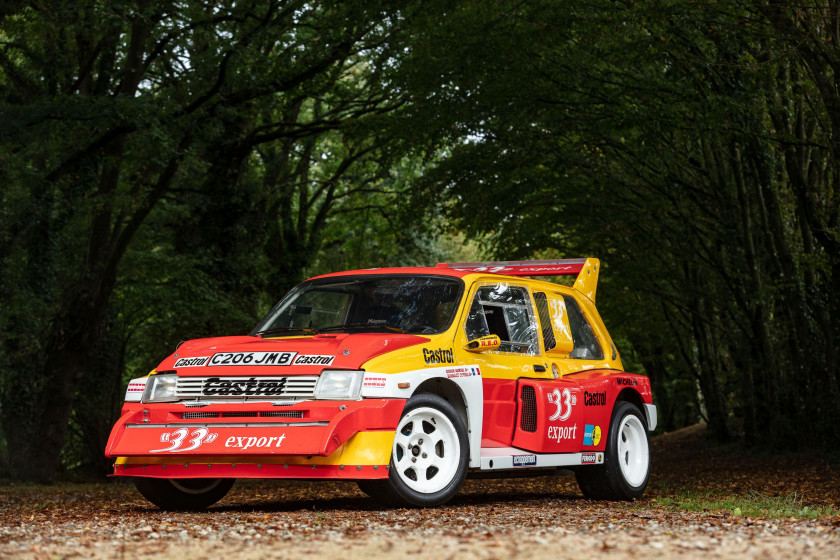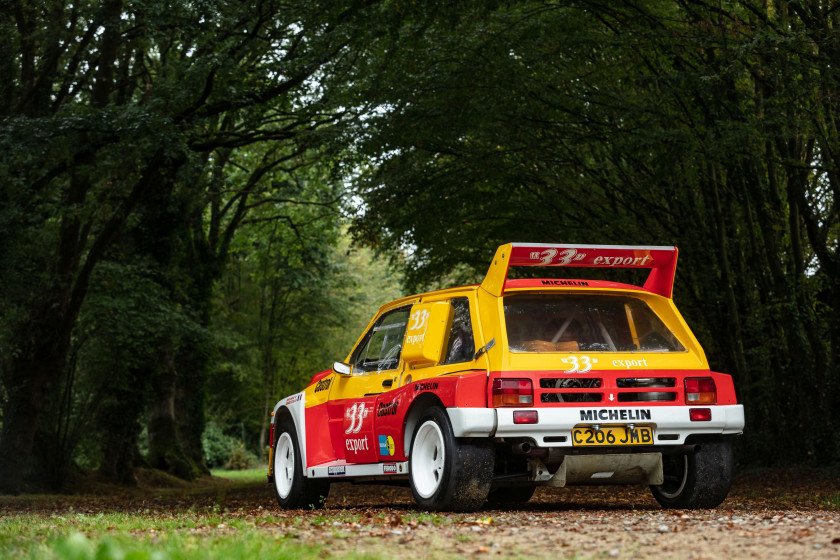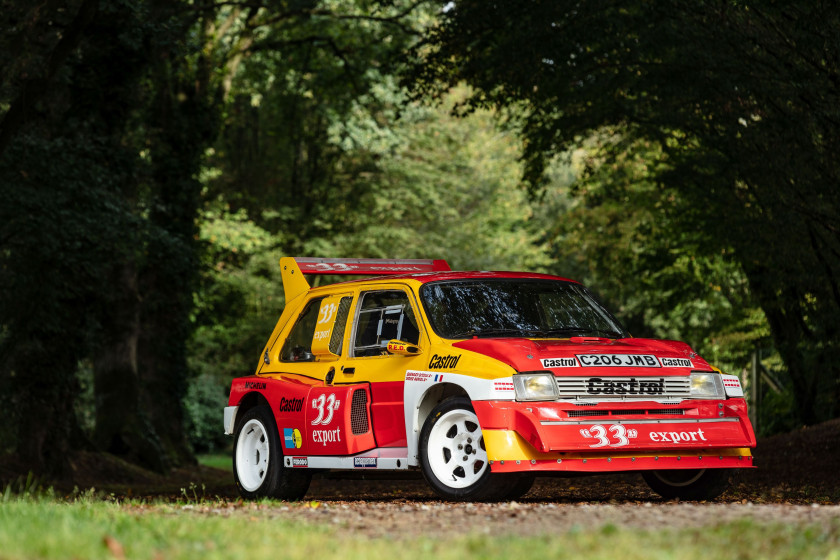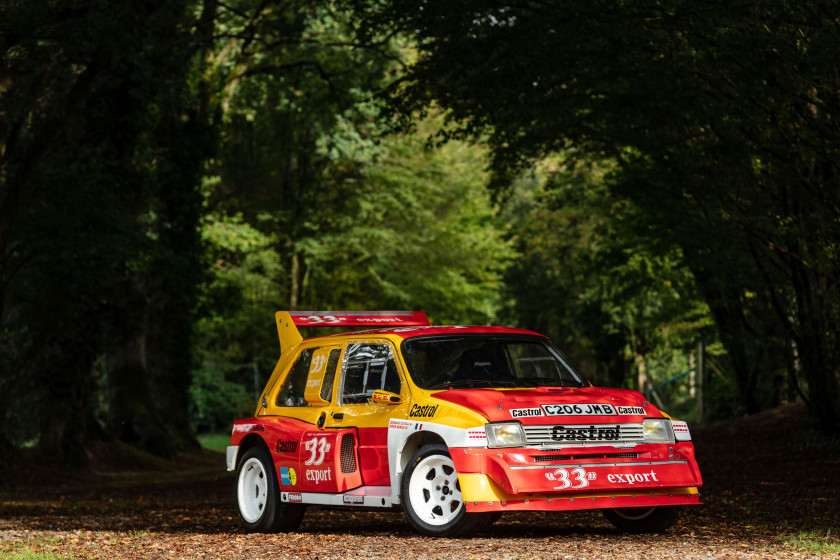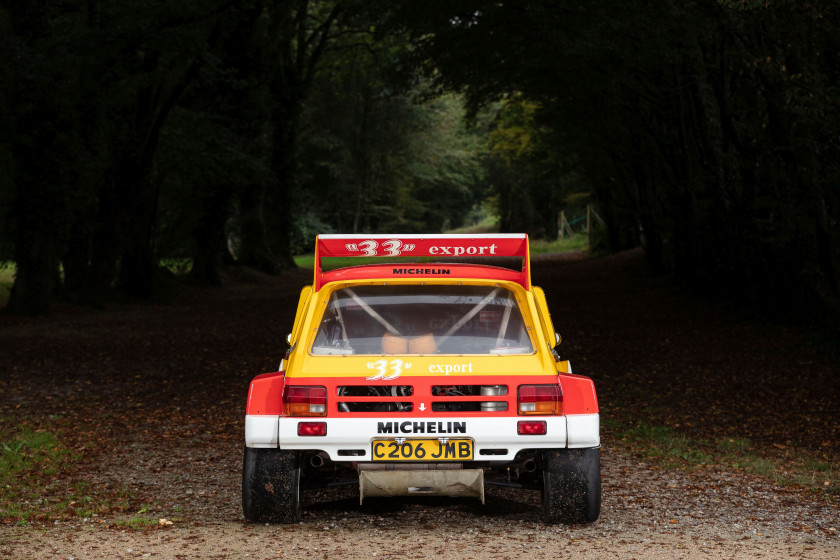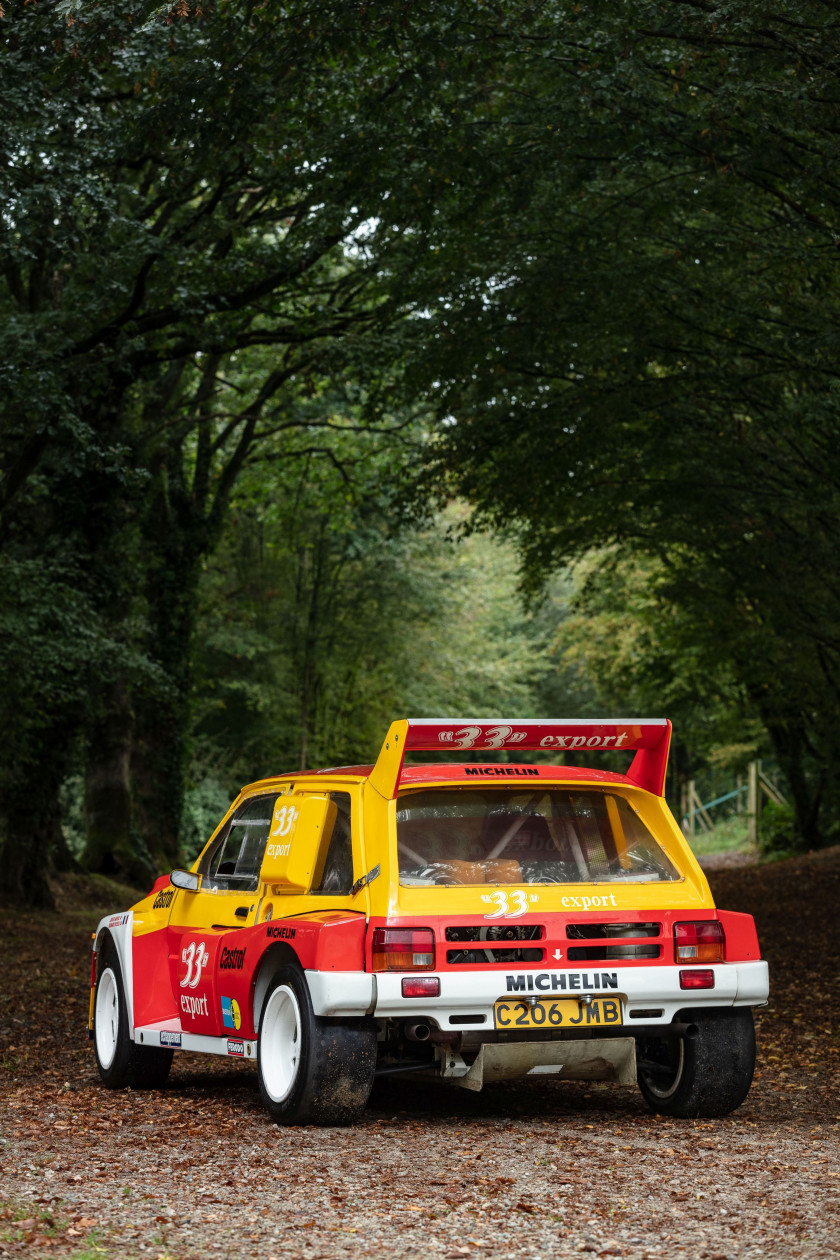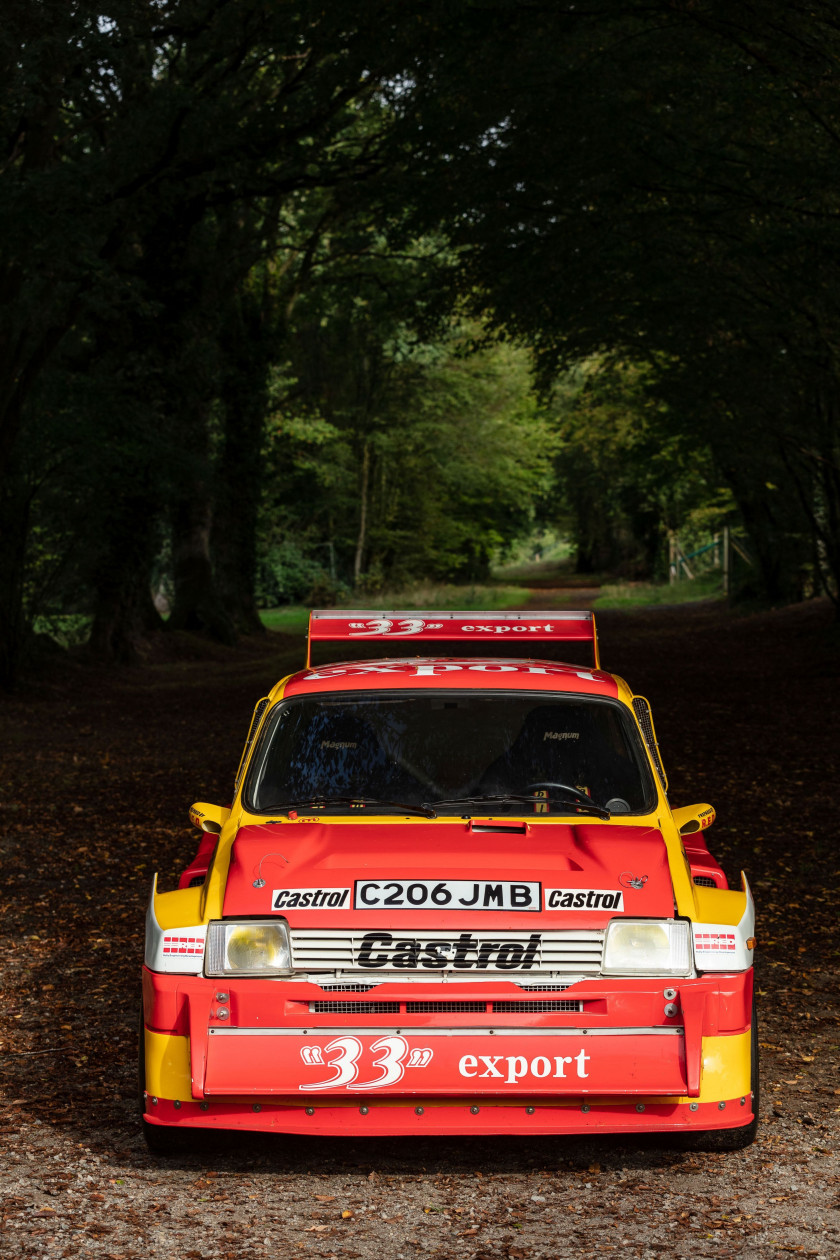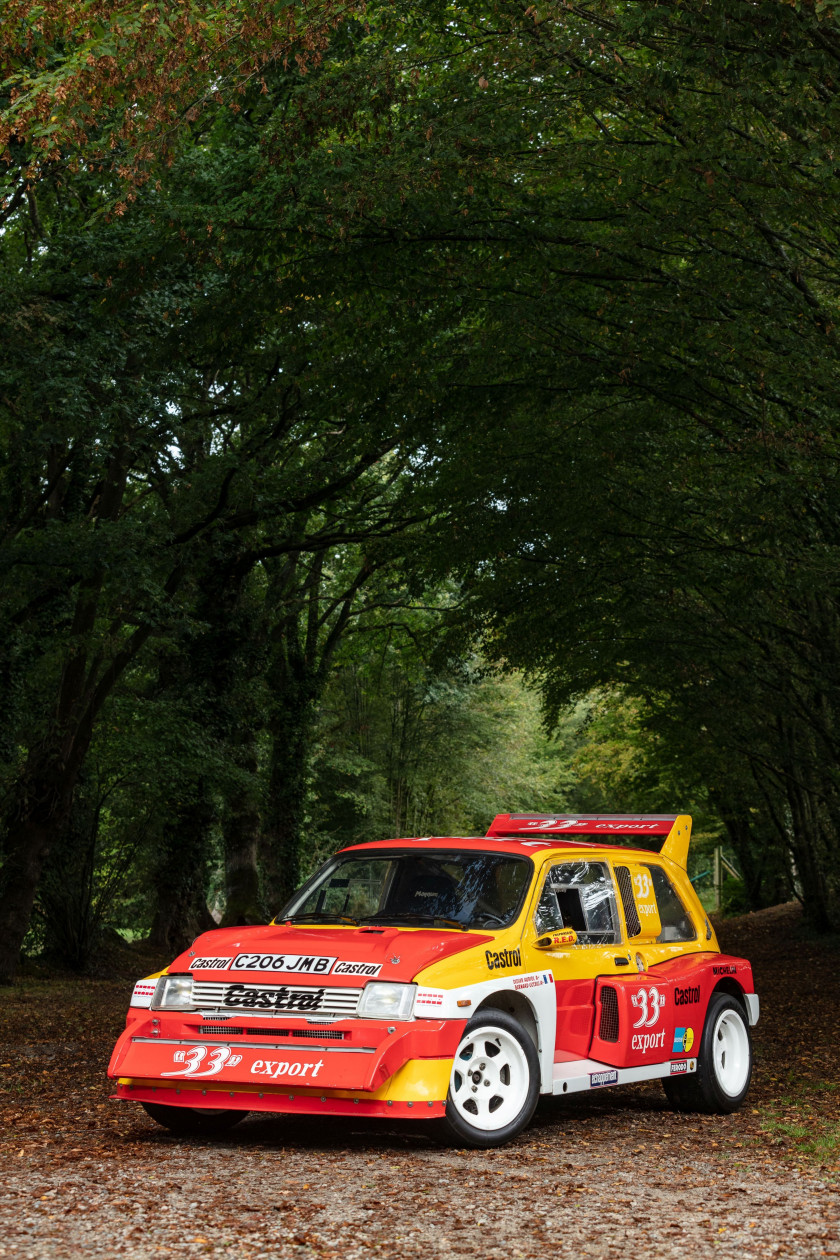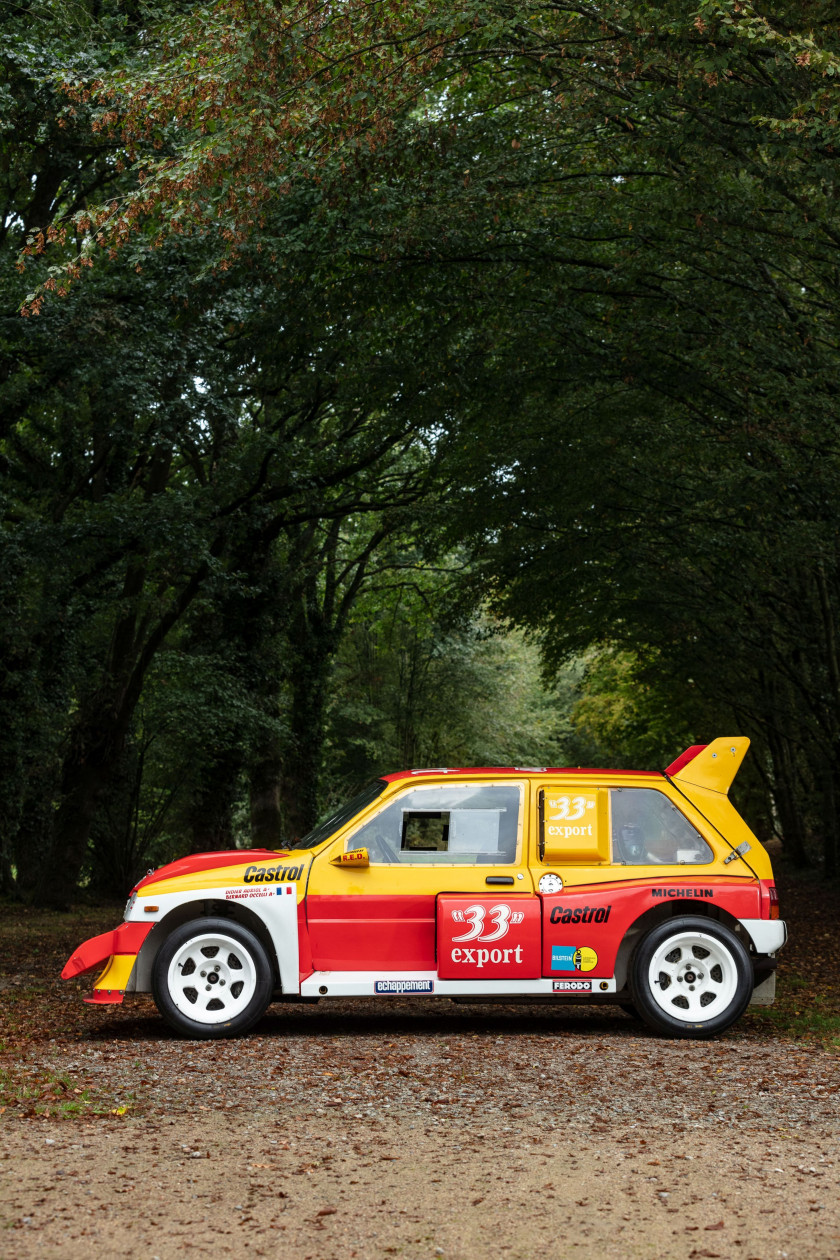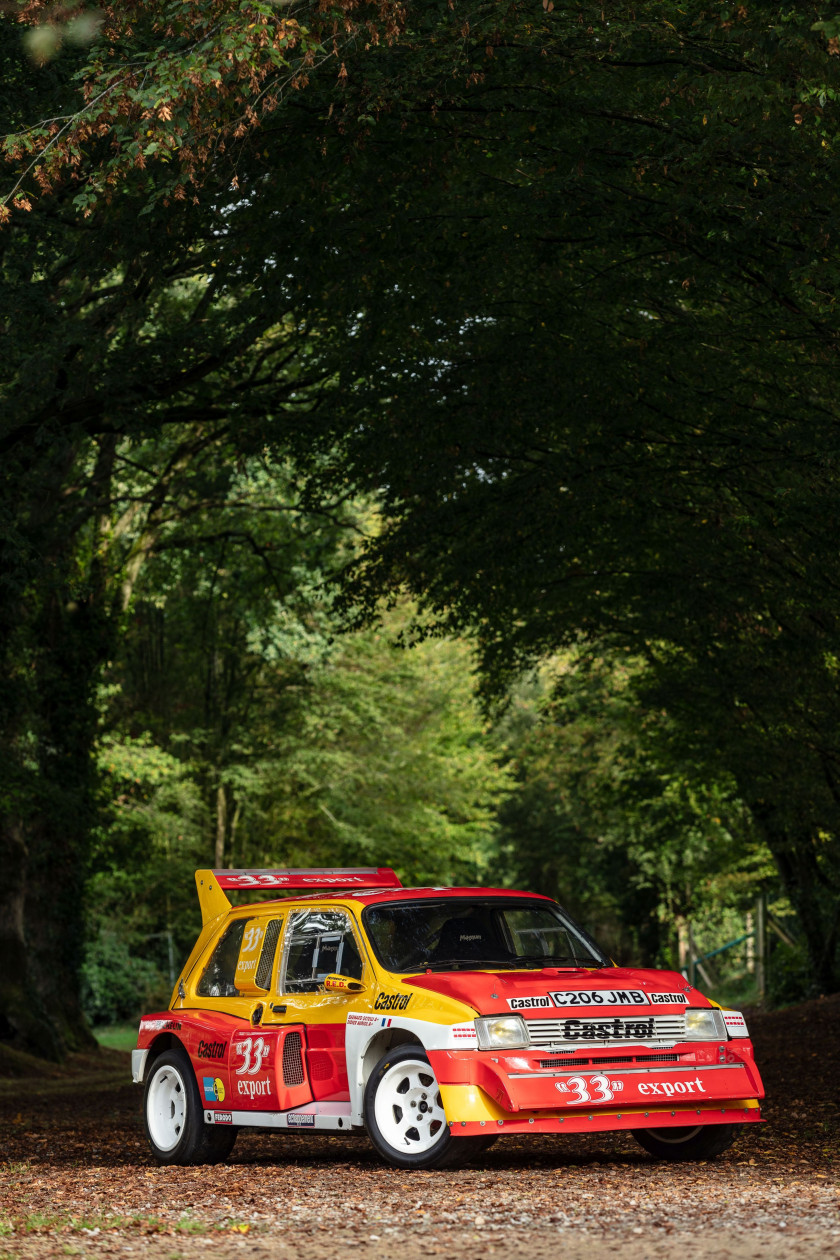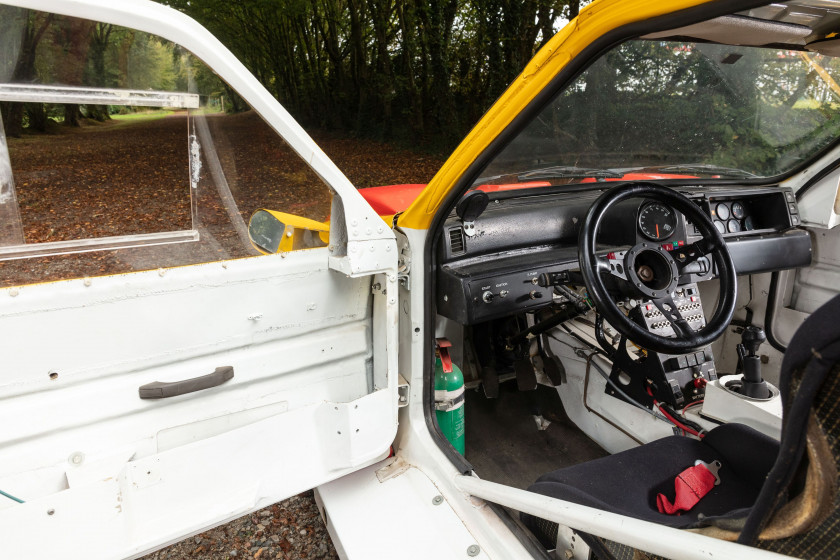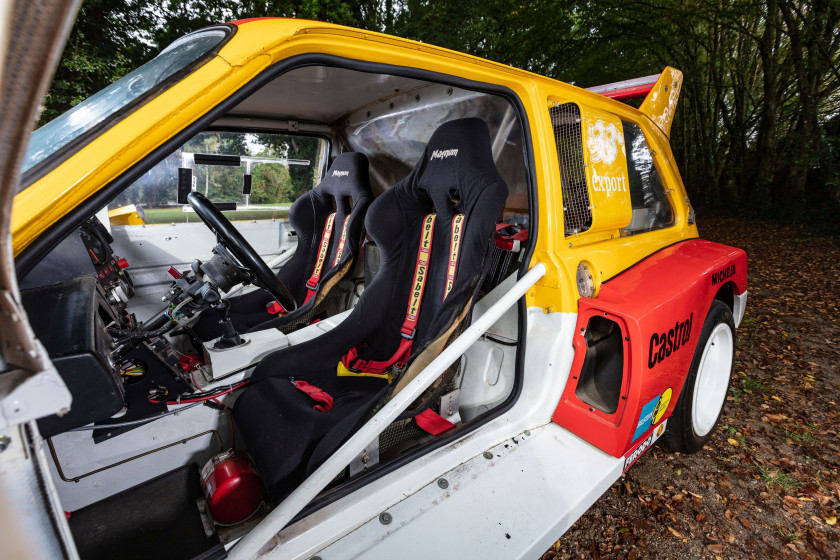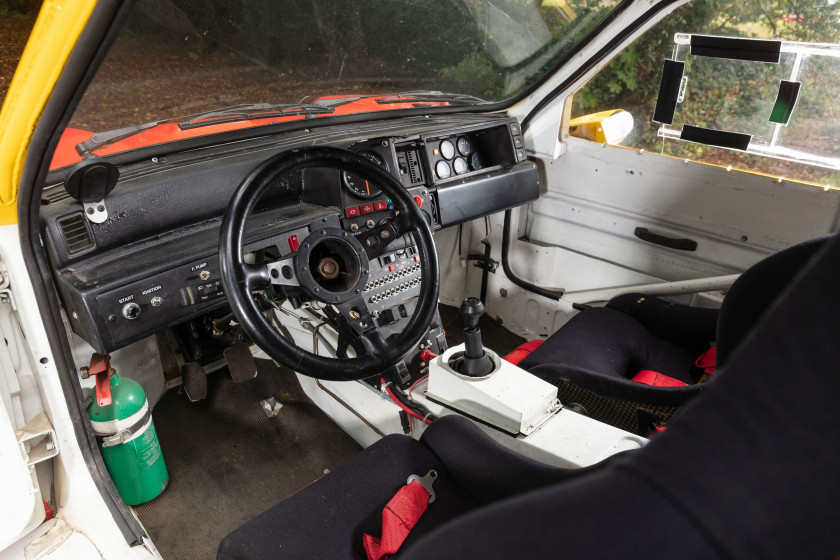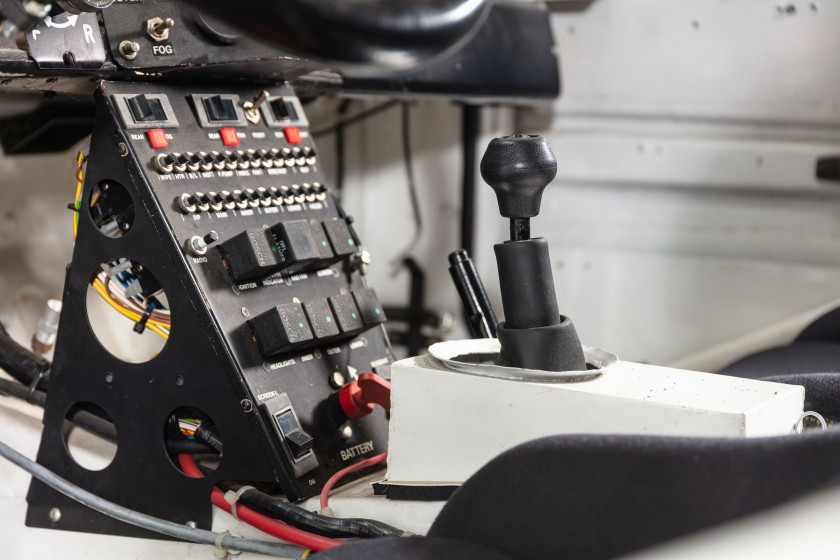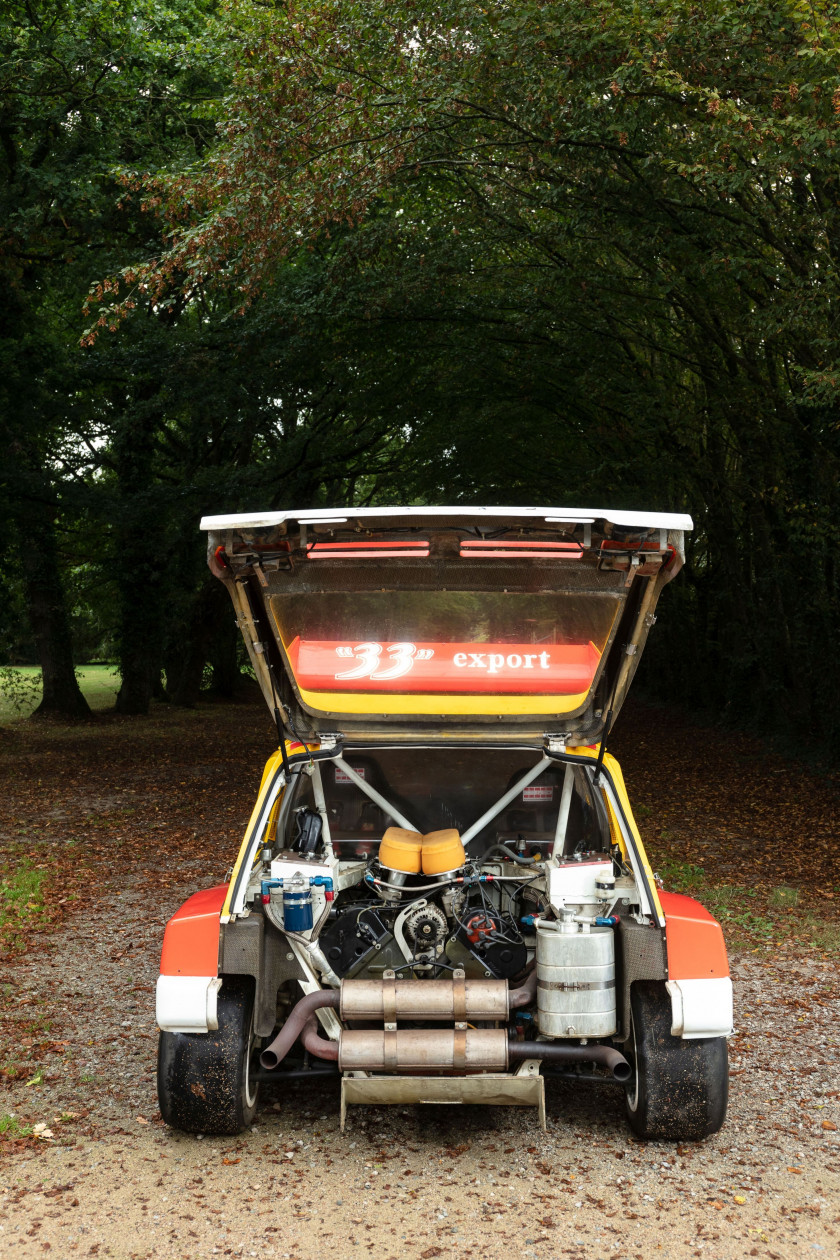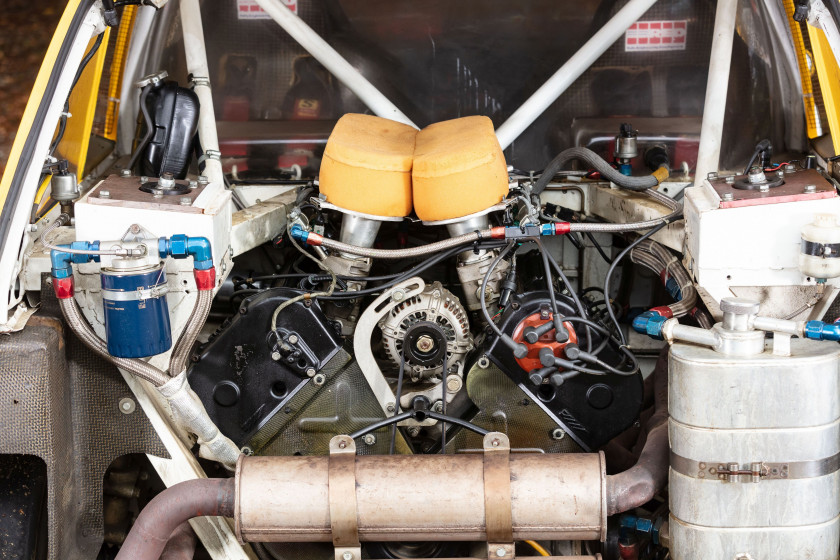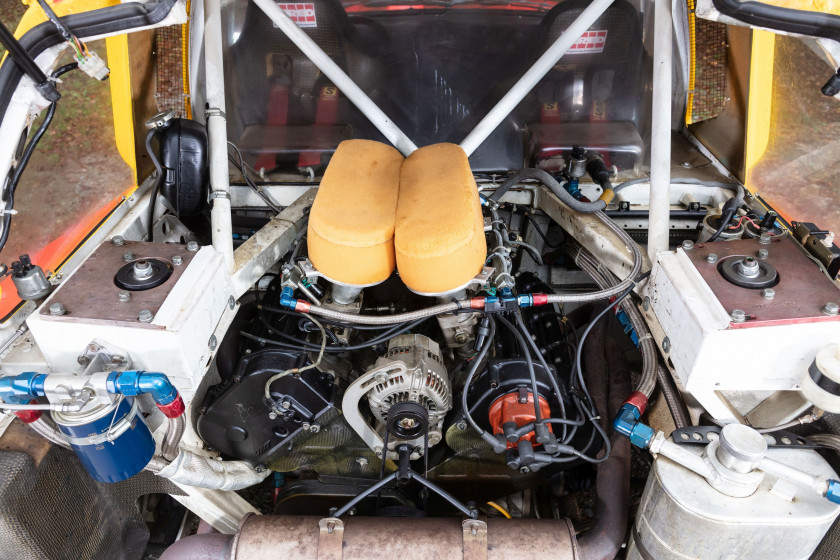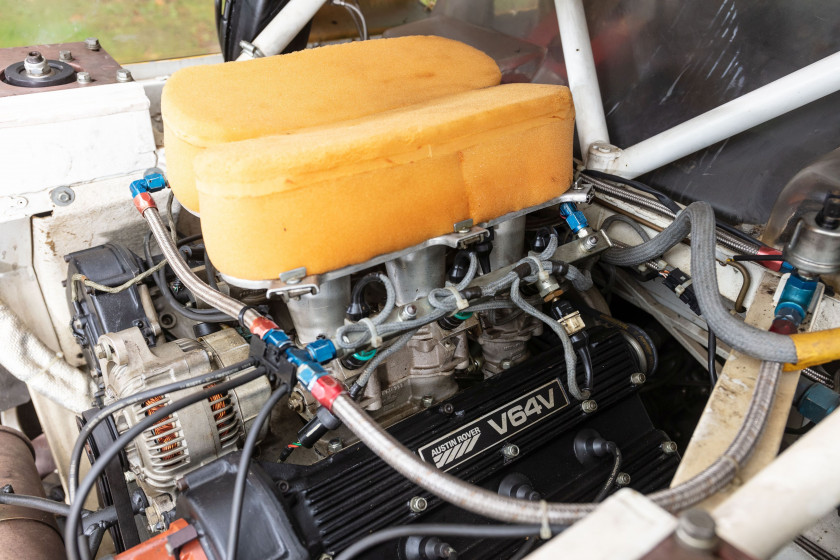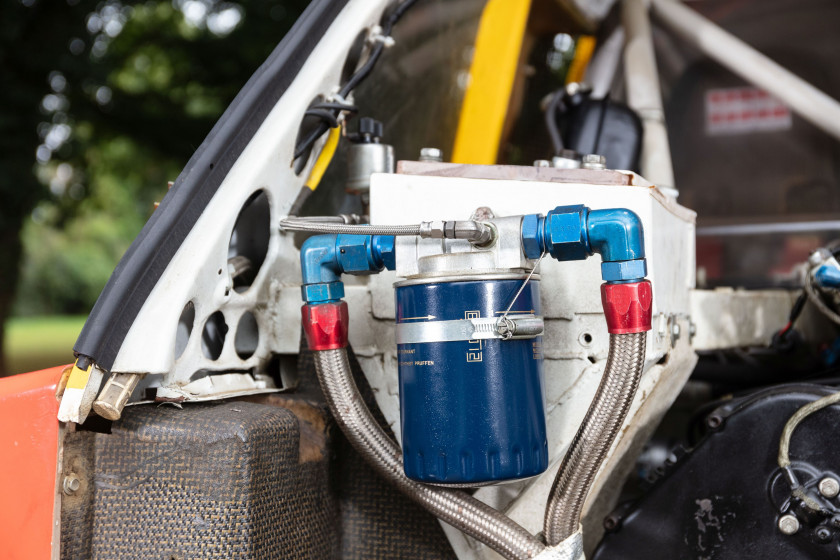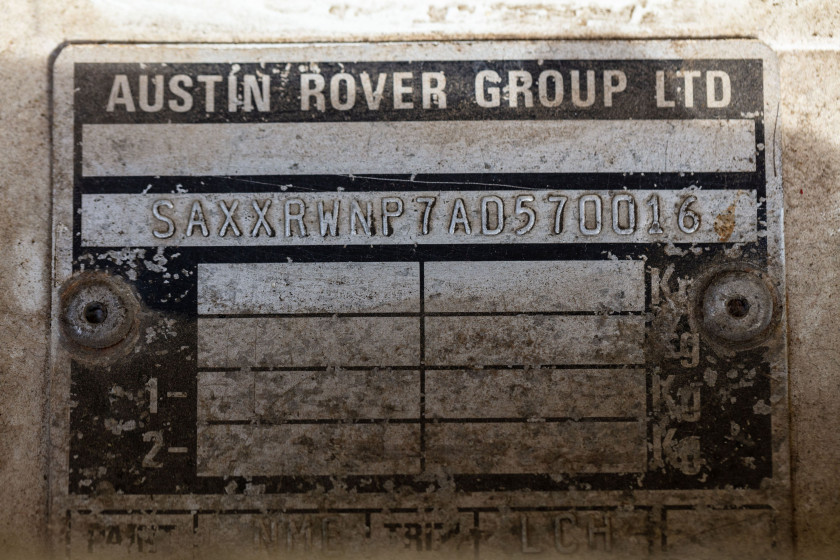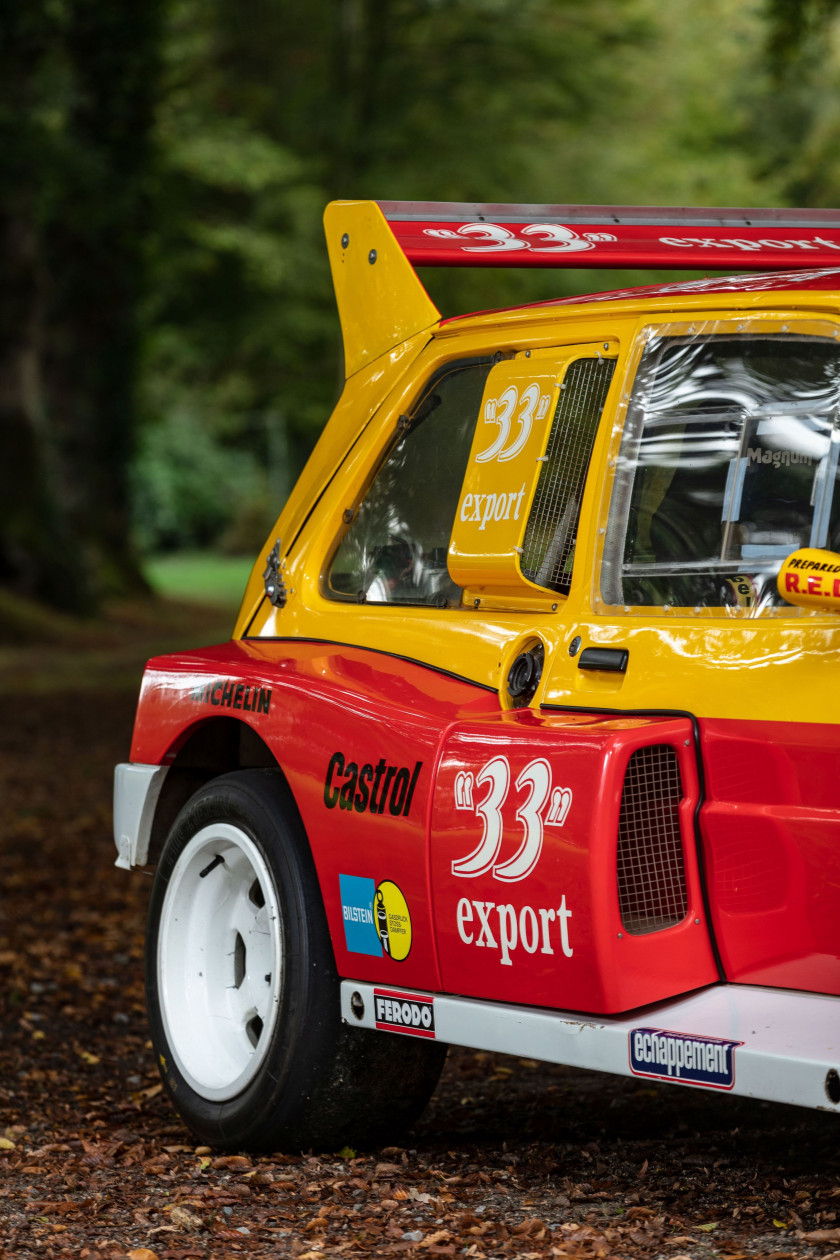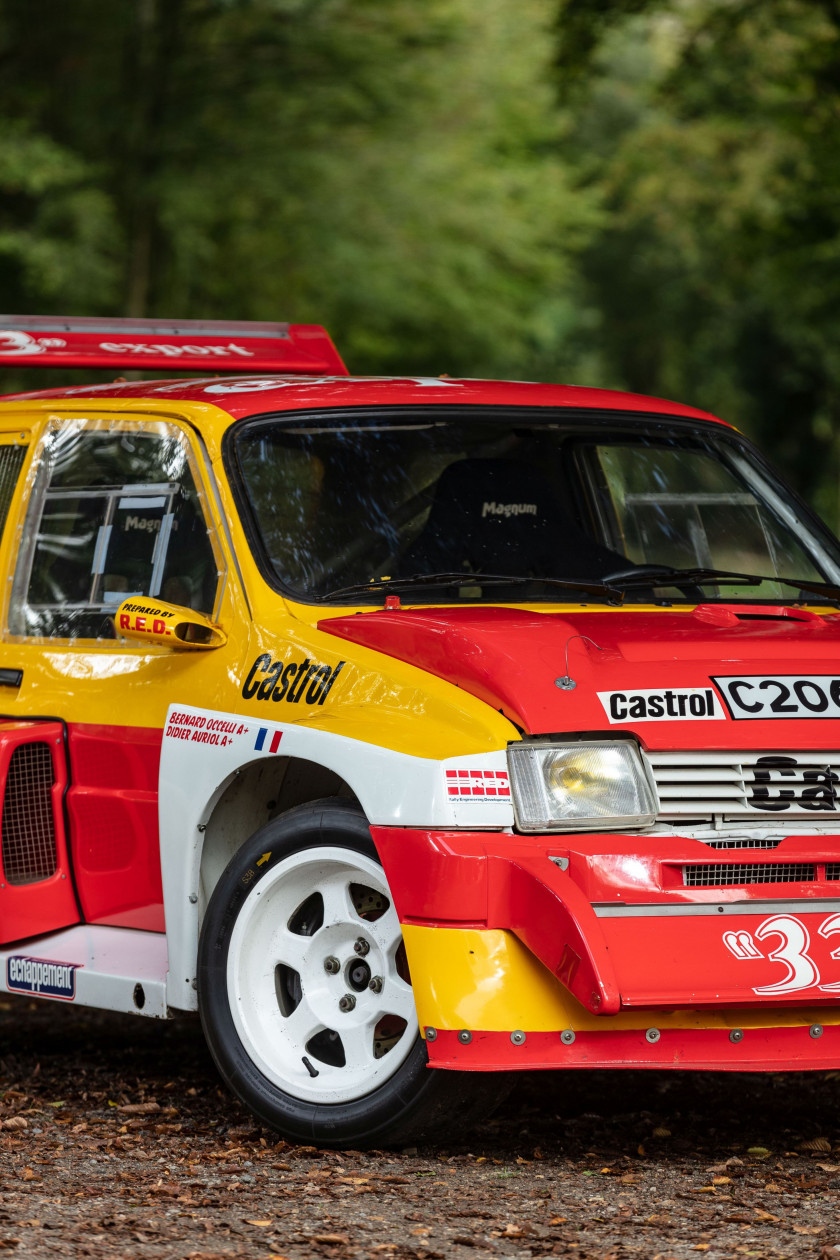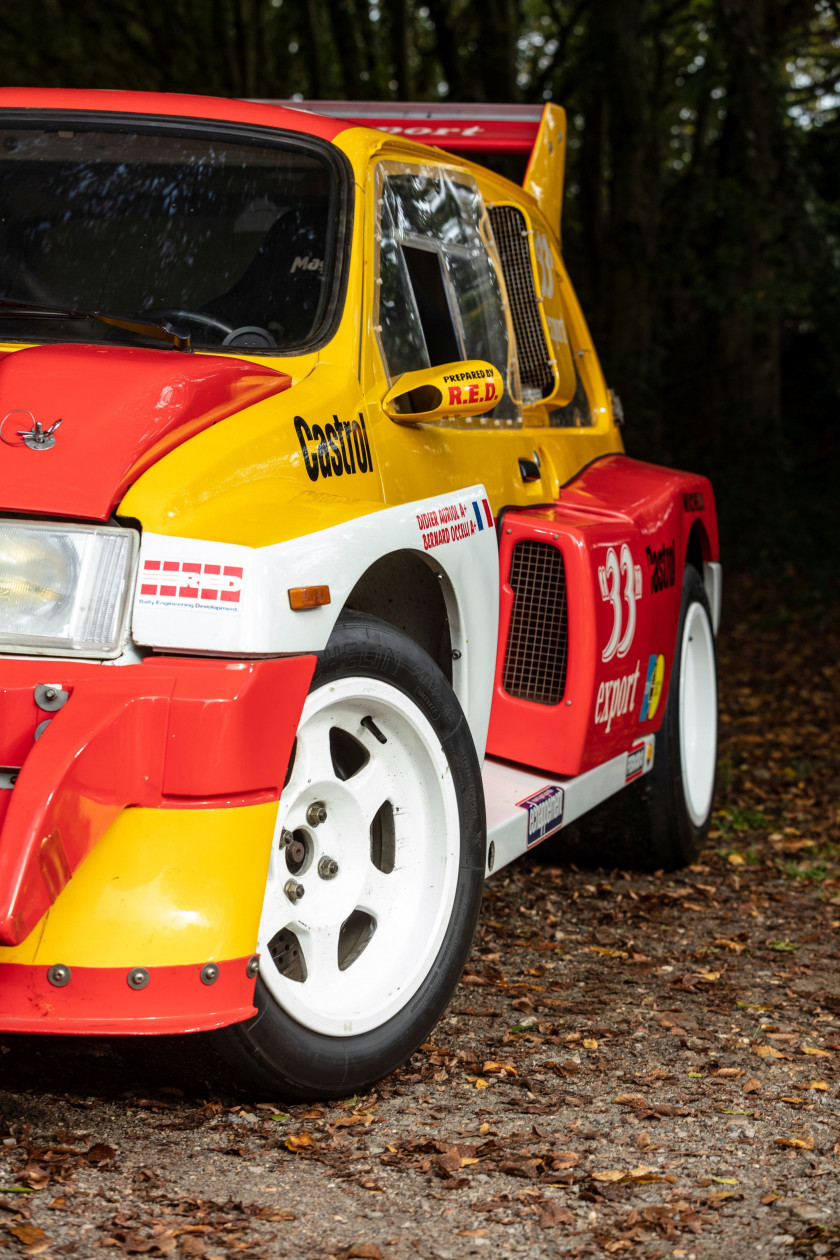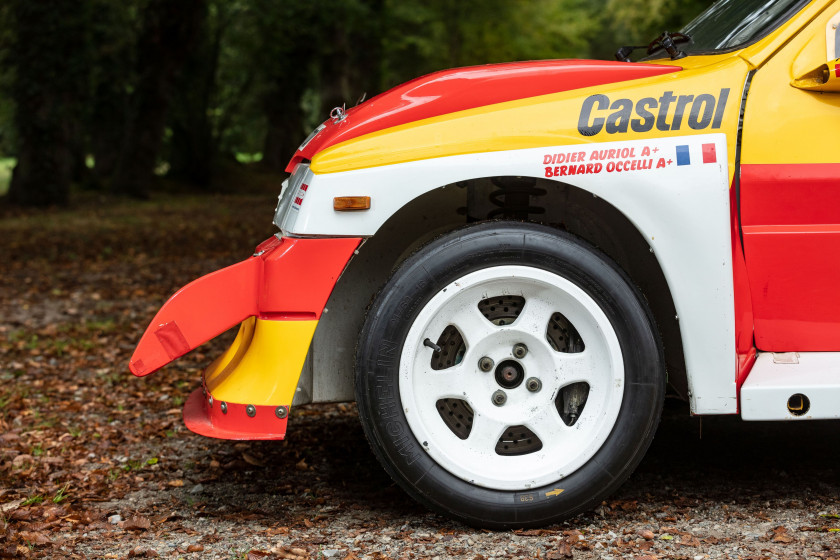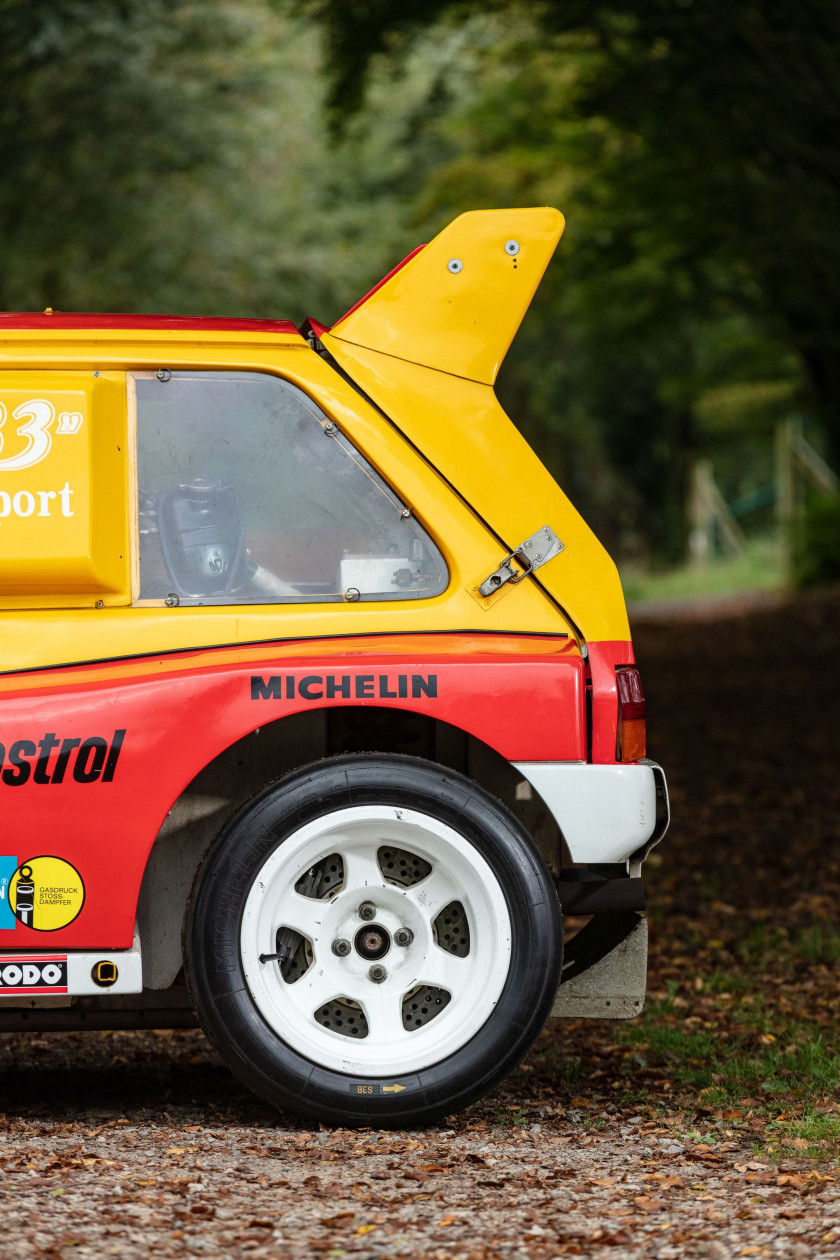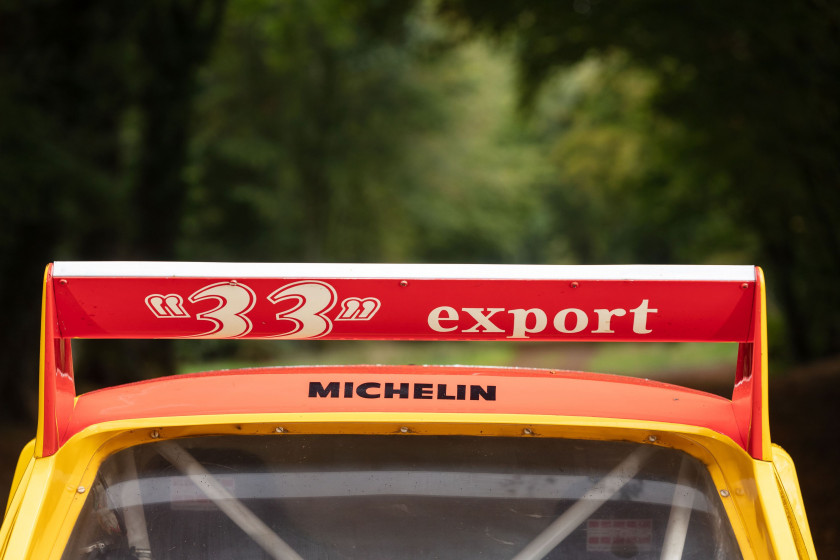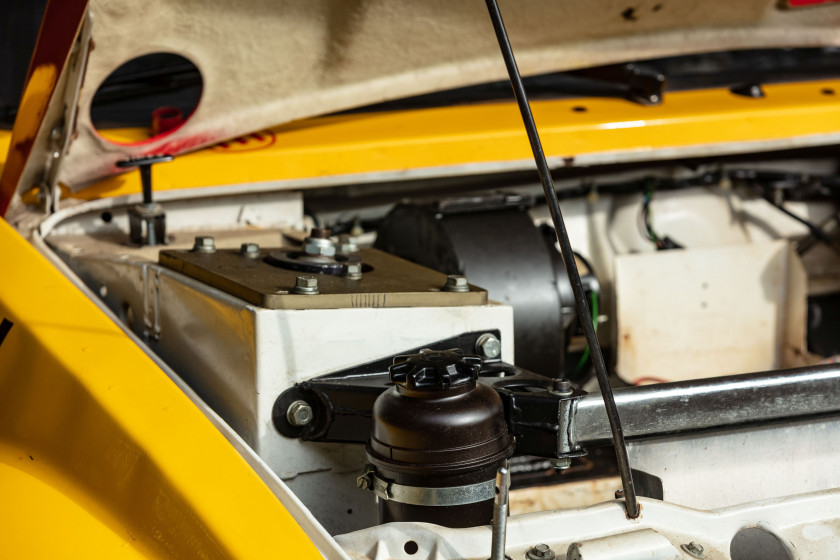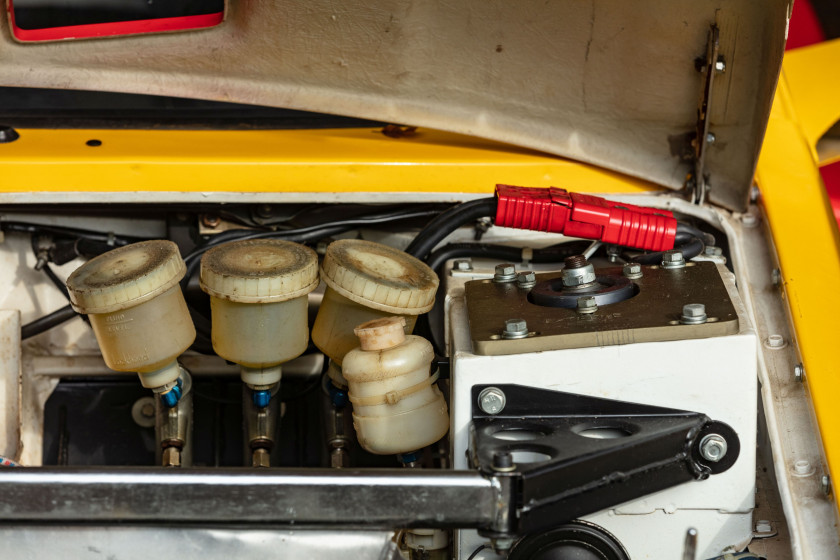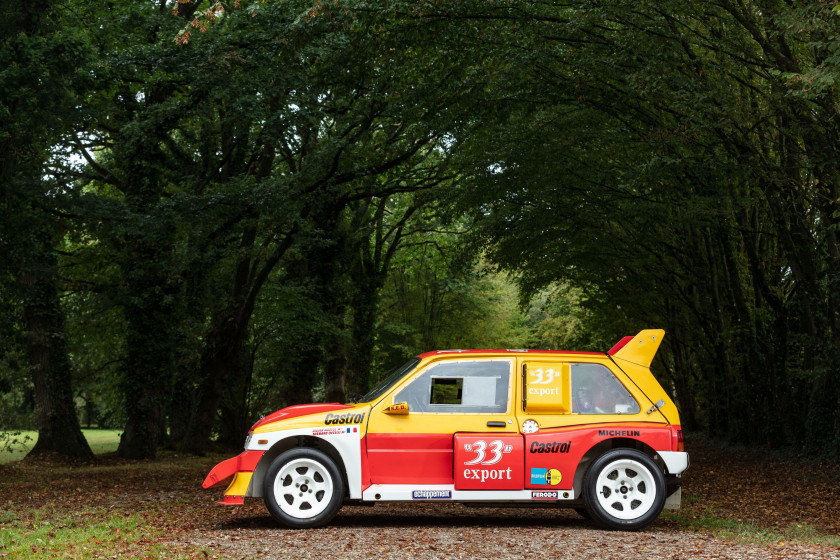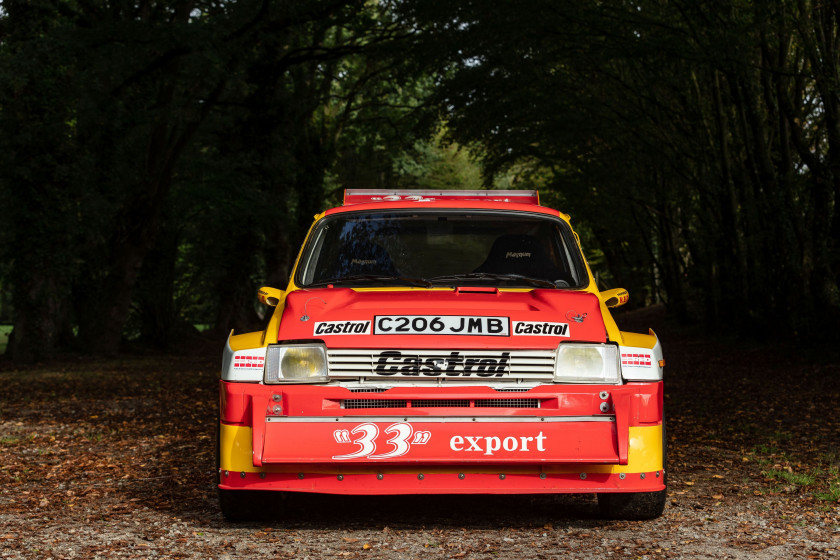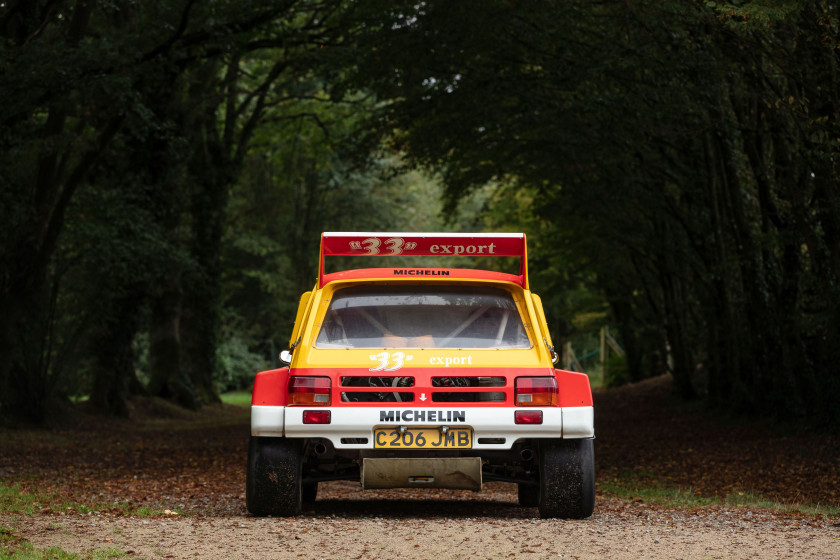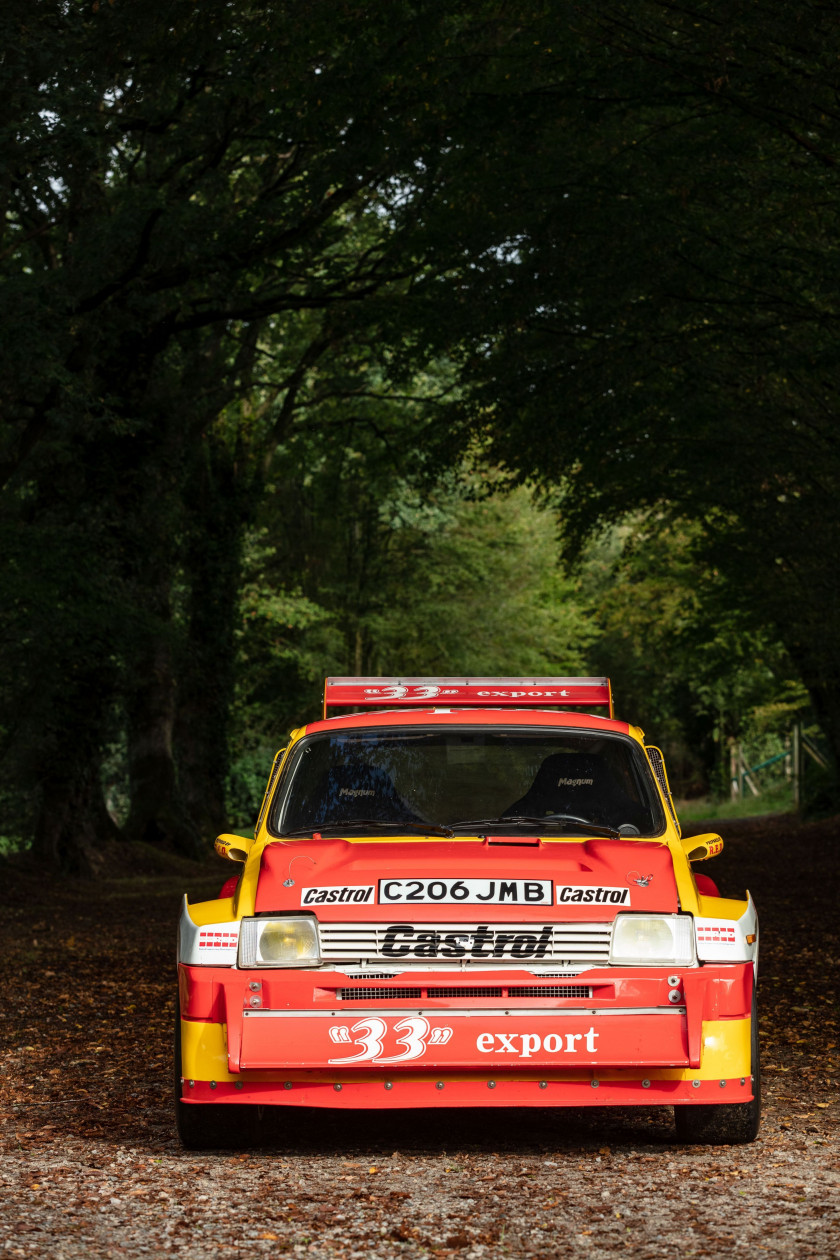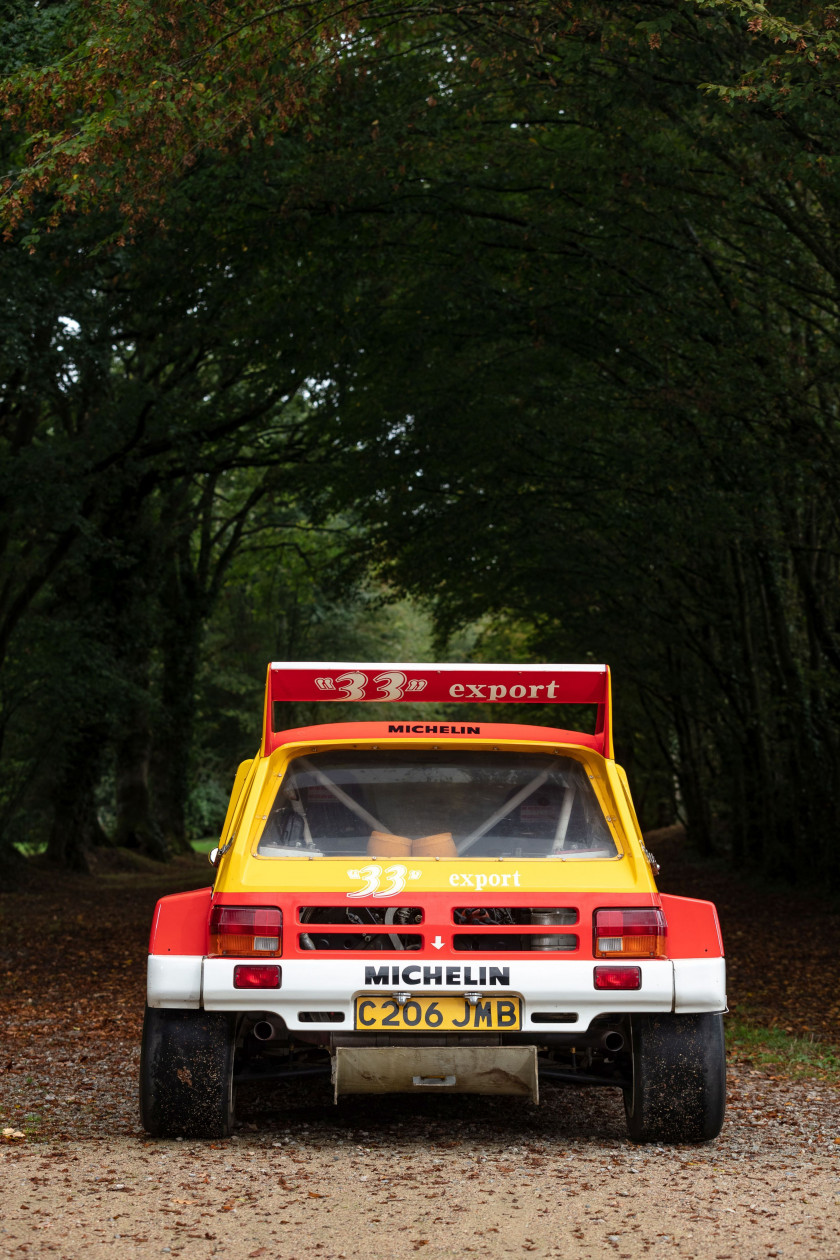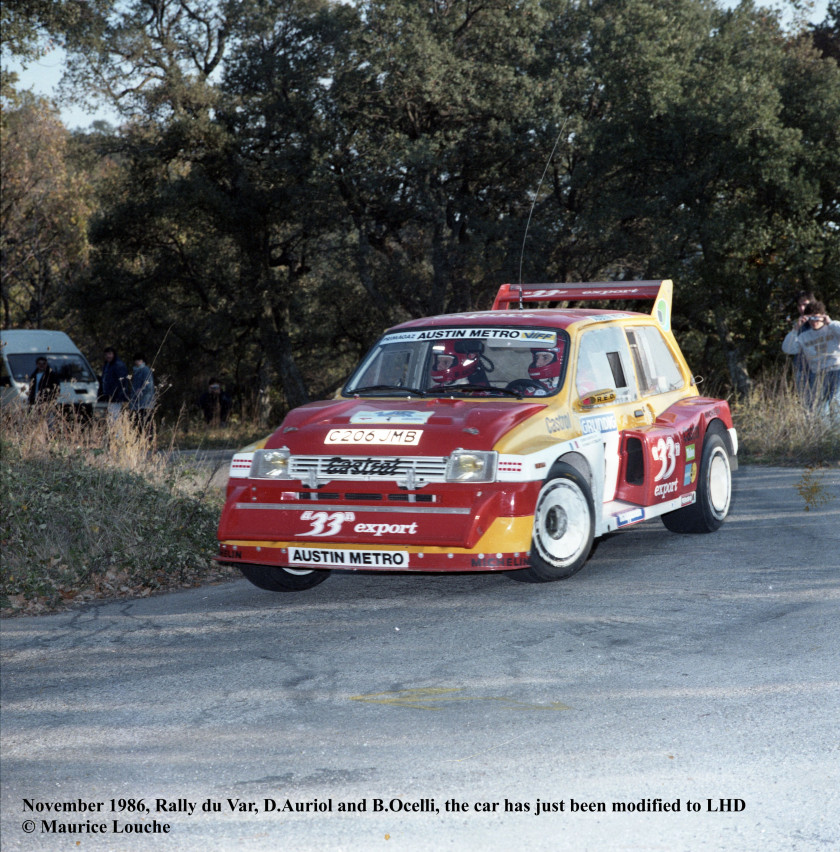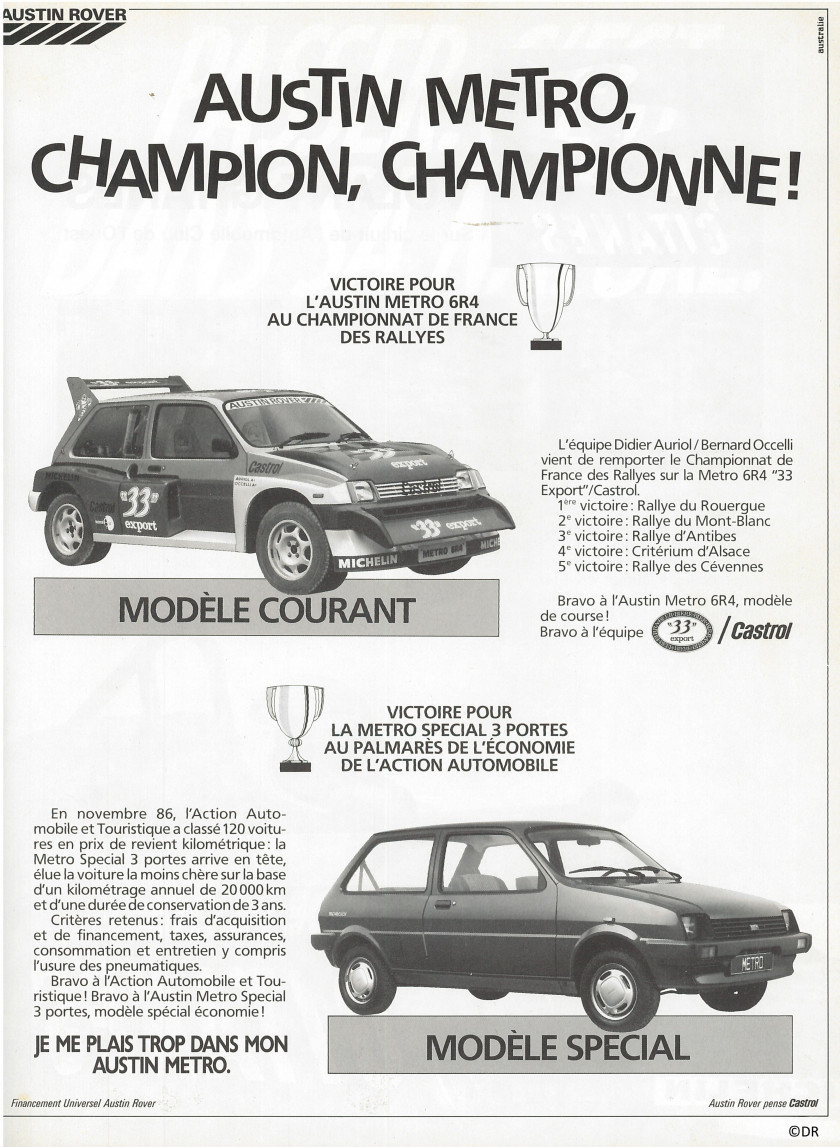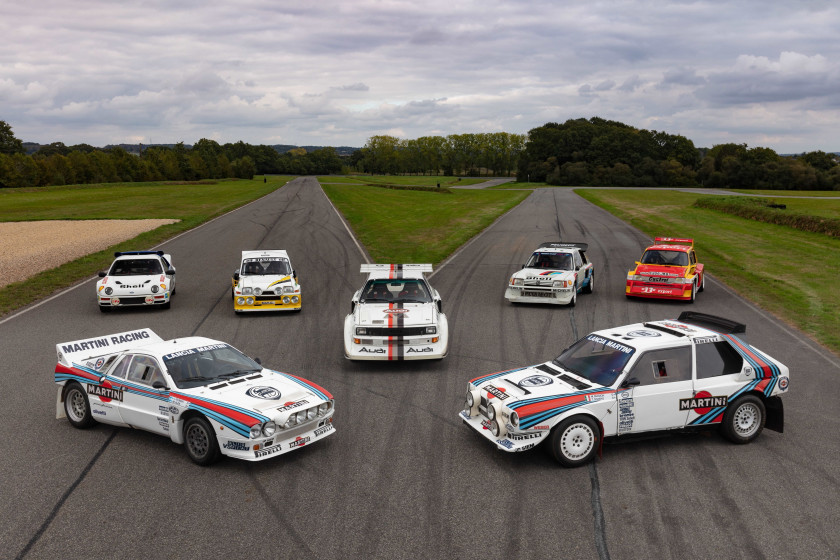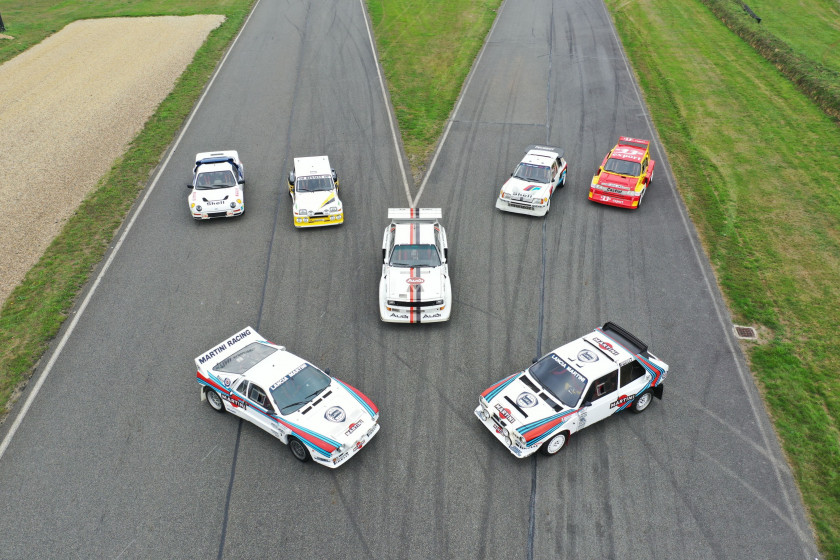Sale Parisienne 2021 - 05 february 2021 /Lot 10 1985 MG Metro 6R4
1985 MG Metro 6R4
Titre de circulation britannique
Châssis n° SAXXRWNP7A0570016
- Appartient au Manoir de Lohéac depuis 1989
- Voiture du titre, Championnat de France des Rallyes 1986
- Remarquable état de préservation
- Pilotée par un Champion du Monde français
Au tout début des années 80, British Leyland est représenté en rallye par la Triumph TR7 V8 (dite TR8), avant de se désintéresser de cette discipline au profit du circuit. L'arrivée du Groupe B fait renaître l'intérêt de la firme et il en résulte une des machines les plus singulières de cette catégorie : la Metro 6R4. Elle fait partie des plus courtes de cette catégorie et caser sa mécanique sophistiquée dans un volume si réduit sera un véritable tour de force.
Sous la direction de John Davenport, à la tête du service compétition d'Austin Rover, et avec la collaboration de Patrick Head chez Williams Grand Prix, le projet de "Very High Performance Derivative"(VHPD) est d'abord envisagé avec un V8 Rover à l'avant d'une Métro transformée en propulsion. Mais la position centrale du moteur s'impose rapidement et, pour en limiter l'encombrement, le V8 est modifié en V6 par l'ablation de deux cylindres. Ce moteur 2,5 litres installé sur le prototype délivre 250 ch dans sa version initiale et il a l'originalité de rester en alimentation atmosphérique : pour le constructeur, non seulement cette formule évite le temps de réponse du turbo, mais elle pose moins de problèmes de refroidissement.
Une transmission intégrale est indispensable pour être au niveau de la concurrence et le jeune ingénieur Bernie Marcus place la boîte à côté du moteur, derrière le siège copilote (à gauche), un viscocoupleur Ferguson assurant la répartition de la puissance entre les trains avant et arrière. Cette architecture donne son appellation à la voiture : "6 cylinder Rally 4 wheel drive" (6R4), et le premier prototype roule en février 1983, année entièrement consacrée à la mise au point. En 1984, la voiture est présentée officiellement, puis engagée à diverses épreuves mais elle doit être encore homologuée en Groupe B. Pour cela il lui faut un moteur spécifique : ce sera le "V64V", un V6 quatre arbres 3 litres conçu par David Wood (ex-Cosworth), développant 250 ch sur la Clubman de base et 380/410 ch en version "usine".
Ainsi, entre août et octobre 1985, 200 exemplaires sortent des ateliers et la voiture peut être engagée au Championnat du Monde des Rallyes, avec comme pilotes Tony Pond, Marc Duez et Malcolm Wilson. Lors de sa première course au RAC de fin 1985, la Metro signe une belle troisième place derrière deux Lancia Delta S4 (dont c'est aussi la première épreuve !). Malheureusement, ce résultat ne sera pas confirmé et de nombreux abandons émailleront la saison 1986. L'arrêt inattendu du Groupe B empêchera l'équipe anglaise de tirer tout le potentiel de sa petite machine survitaminée, bardée d'ailerons et transfigurés par ses élargisseurs d'ailes.
Pourtant, la Metro 6R4 va se distinguer lors d'autres épreuves et championnats, avec par exemple une victoire internationale au Rallye d'Irlande 1986 avec David Llewellin et, en France, le titre au Championnat de France des Rallyes de la même année, entre les mains de Didier Auriol, avec la voiture qui est ici proposée à la vente.
La voiture de la vente
En 1984/1985, Austin Rover France approche John Davenport pour engager une voiture au Championnat de France des Rallyes, avec Didier Auriol. Un appel d'offres est effectué auprès d'écurie privées et Rally Engineering Development (RED) basé à Widnes, près de Liverpool, s'y intéresse. Née en 1979, cette équipe compte en 1984 22 personnes dirigées par Peter Cattanach et se distingue notamment par ses bons résultats avec Ford. L'offre qu'elle fait alors est acceptée, et il s'ensuit un contrat de trois ans avec Austin Rover pour prendre en charge en 1986 le Championnat de France des Rallyes avec Didier Auriol, le Championnat d'Angleterre avec Willie Rutherford et le British Open avec David Llewellin et Henri Toivonen.
L'écurie anglaise et le pilote français ne se connaissent pas, mais ils vont entretenir d'excellentes relations, à tel point que Cattanach dira d'Auriol qu'il fait partie des cinq meilleurs pilotes de rallye du monde.
Ainsi, RED prépare une voiture pour le Championnat de France 1986, transformant une Clubman d'homologation aux spécifications usine avec des pièces fournies par le département course d'Austin Rover. Le 19 novembre 1985, elle est immatriculée C206 JMB, comme en témoigne le "Vehicle Registration Document" original, au nom de RED, qui figure dans le dossier.
La saison commence doucement avec deux abandons (pompe à huile, puis distributeur), mais elle connaît ensuite un affrontement haletant entre la Metro "33 Export" de Didier Auriol et son copilote Bernard Occelli, et la Renault 5 Maxi de François Chatriot. Les deux pilotes totalisent à la fin de la saison le même nombre de points, 119, mais Auriol a remporté cinq victoires, contre quatre pour le pilote Renault. C'est donc Auriol qui emporte le titre !
Au début de la saison, Didier Auriol se plaint de la conduite à droite de la voiture, avant la fin de l'année et comme le montre les photos lors du rallye du Var en novembre, la voiture est convertie en conduite à gauche. Ce qui explique que le tableau de bord soit en face du navigateur, seul un gros compte-tours faisant face au pilote alors que les commandes principales sont réunies sur la console centrale. Une particularité unique à cette voiture !
Malgré l'arrêt du Groupe B, il décide de rester chez RED et effectue les saisons 1987 et 1988 avec l'écurie anglaise et une Ford Sierra Cosworth, remportant à nouveau le Championnat de France des Rallyes.
Pour revenir à la Metro, obsolète après la saison 1986, elle est donc remisée. Remarquée par le patron de California Automobiles, important négociant de Cannes, elle est importée en France en 1988, un certificat des douanes françaises daté du 20 septembre 1988 en attestant. De là, elle est vendue en 1989 à Michel Hommell, et rejoint immédiatement le musée. Le dossier comporte la facture d'achat originale, datée du 10 mai 1989 auprès d'un important négociant automobile, connaissant bien les voitures de Rallye.
Didier Auriol était particulièrement attaché à cette voiture, comme nous l'a rappelé Olivier Quesnel : "Il m'a demandé plusieurs fois de la racheter, mais nous n'avons jamais accepté."
Aujourd'hui, cette voiture se présente dans un état d'origine rare pour une voiture de rallye. Son histoire ne présente aucun "blanc" entre sa préparation et aujourd'hui : avec un passage presque direct du rallye au musée, elle appartient depuis 1989 aux mêmes propriétaires. Parmi les légendes du Groupe B, c'est un modèle attachant et atypique, avec son gros V6 atmosphérique dans une carrosserie courte et ramassée.
Nous informons les acheteurs que l'ensemble des véhicules de la collection ont été peu utilisés ces dernières années s'agissant d'une collection muséale. Ils sont donc vendus en l'état, sans contrôle technique et devront bénéficier d'une révision générale avant de reprendre la route.
Didier Auriol
Pilote à la personnalité discrète, natif de Montpellier, Didier Auriol a la particularité d'être le premier pilote français à avoir décroché le titre Conducteurs du Championnat du Monde des Rallyes. Cela se passe en 1994, à bord d'une Toyota Celica usine. Avant cela, il a ouvert son palmarès en 1986 avec son premier titre de Champion de France des Rallyes, au volant de la présente Metro 6R4. Avec RED et une Ford Sierra Cosworth, il décroche le même résultat en 1987 et 1988, ce qui lui ouvre à partir de 1989 la porte de l'équipe Lancia usine pour le Championnat du Monde des Rallyes, avec la Delta Integrale. Malgré de bons résultats (en 1992, il remporte six victoires), le titre lui échappe et il termine troisième en 1991 et 1992. Il passe alors chez Toyota et, après à nouveau une troisième place en 1993, le titre mondial est à lui l'année suivante, en 1994 ! C'est le couronnement d'une carrière de haut niveau. D'ailleurs, Didier Auriol s'est adjugé quatre fois le titre de "Champion des champions" à la course des champions, en 1993, 1994, 1996 et 1999. Un record !
British title
Chassis no. SAXXRWNP7A0570016
- Owned by the Manoir de Lohéac since 1989
- Winning car from the 1986 French Rally Championship
- Remarkable condition
- Driven by a French World Champion
At the start of the 1980s, British Leyland was represented in rallying by the Triumph TR7 V8 (or 'TR8'), before giving up the sport in favour of track racing. The arrival of Group B rekindled its interest in rallying and gave rise to one of the most remarkable cars in its class, the Metro 6R4. It was one of the shortest cars in the class and slotting its sophisticated engine into so small a space would be a real feat.
Under the direction of John Davenport, Austin Rover's head of motorsport, and with help from Patrick Head from Williams Grand Prix, the 'Very High Performance Derivative' (VHPD) project was initially conceived with a Rover V8 installed at the front of a Metro that had been converted to rear-wheel drive. But a mid-engined layout soon seemed the obvious solution, and to save space, the V8 was converted into a V6 by removing two cylinders. The 2.5-litre engine installed in the prototype produced 250 bhp in its initial form and was unusual in remaining naturally aspirated: for the manufacturer, this avoided turbo lag and caused fewer cooling problems.
Four-wheel drive was essential for the car to be competitive, and the young engineer Bernie Marcus placed the gearbox next to the engine, behind the co-driver's seat, with a Ferguson viscous coupling managing the distribution of power between the front and rear wheels. This layout gave the car its name: '6-cylinder Rally 4-wheel drive' (6R4), and the first running prototype was ready in February 1983, the whole of that year being devoted to its development. In 1984, the car was officially presented and entered in various events, but it had yet to be homologated in Group B. For this, it needed a bespoke engine: this would be the 'V64V', a quad-cam 3-litre unit designed by David Wood (ex-Cosworth), which produced 250 bhp in the basic Clubman model and 380-410 bhp in the 'works' version.
Between August and October 1985, 200 cars duly left the workshop, and the Metro could be entered in the World Rally Championship, driven by Tony Pond, Marc Duez and Malcolm Wilson. On its first rally, the RAC at the end of 1985, the Metro finished third, a fine result behind two Lancia Delta S4s (also on their first outing!). Unfortunately, this result proved inconclusive and the 1986 season was marred by several retirements. The unexpected end of Group B prevented the English team from getting all they could out of this little slingshot, its looks transformed by an array of spoilers and wheel-arch extensions.
The Metro 6R4 nonetheless went on to distinguish itself elsewhere, with David Llewellin winning the Circuit of Ireland Rally in 1986, and Didier Auriol claiming victory in the French Rally Championship that same year, driving the car offered for sale today.
The car for sale
In 1984/85, Austin Rover France approached John Davenport with a view to entering Auriol in a car in the French Rally Championship. Bids were invited from private rally teams and Rally Engineering Development (RED), based near Liverpool, expressed interest. Established in 1979, the company had 22 employees in 1984, led by Peter Cattanach, and had achieved particularly good results with Ford. Its offer was accepted, and the team awarded a three-year contract with Austin Rover, with responsibility in 1986 for the French Rally Championship with Auriol, the English Championship with Willie Rutherford and the British Open with Llewellin and Henri Toivonen.
The English team and the French driver didn't know each other, but hit it off very well, Cattanach going so far as to say that Auriol was one of the five best rally drivers in the world.
RED duly prepared a car for the 1986 French Championship, converting a Clubman homologation model to full works specification, using parts supplied by Austin Rover's motorsport department. On 19 November 1985, it was registered C206 JMB, as can be seen from the original Vehicle Registration Document, in the name of RED, which is included in the history file.
The season got off to a slow start with two retirements (for oil pump then distributor failures), but these were followed by a breathtaking battle between the '33 Export' Metro of Auriol and his co-driver Bernard Occelli, and the Renault 5 Maxi driven by François Chatriot. At the end of the season, the two drivers each had 119 points, but Auriol had notched up five wins, against four for the Renault driver. And so Auriol won the title! Despite the ban on Group B, he decided to stay at RED and drove a Ford Sierra Cosworth for the English team in the 1987 and 1988 seasons, again winning the French Rally Championship.
As Didier Auriol, during the beginning of the season, complained a lot about the fact that the car was right hand drive, subsequently, before the end of the season and as it is obvious on some period pictures, of the Rallye du Var in November, the car was converted to left-hand drive. This explains why the dashboard is in front of the navigator, with only a large rev counter on the driver's side, while the main controls are on the centre console. A feature unique to this car!
Meanwhile, the Metro, which had become obsolete after the 1986 season, was put into storage. Noticed by the head of California Automobiles, a major dealer in Cannes, it was imported into France in 1988, as a French customs certificate dated 20 September 1988 confirms. It was then sold in 1989 to Michel Hommell and immediately entered the museum. The history file includes the original sales invoice, dated 10 May 1989.
Auriol was particularly fond of this car, as Quesnel reminded us: "He asked to buy it several times, but Michel Hommell never agreed."
Today the Metro is in unusually original condition for a rally car. There are no gaps in its history between the time it was prepared for rallying and the present day; it went almost directly from the rally stages to the museum and has been in the same ownership since 1989. Among the legends of Group B, it is an appealing and unusual car, with its big naturally-aspirated V6 in a stubby bodyshell.
We inform buyers that all the vehicles in the collection have been little used during the last years as they are part of a museum collection. They are sold as presented and therefore require recommissioning before being driven on the road.
Didier Auriol
Discreet by nature and originally from Montpellier, Didier Auriol has the distinction of being the first Frenchman to win the Drivers' title in the World Rally Championship. He did so in 1994, with a works Toyota Celica. His tally of victories started well before this, in 1986, with his first title as French Rally Champion, driving the Metro 6R4 presented here. With a Ford Sierra Cosworth for RED, he achieved the same result in 1987 and 1988, opening the way for him to join the Lancia works team in the World Rally Championship in 1989, driving a Delta Integrale. Despite good results (in 1992, he notched up six victories), the title eluded him, and he finished third in 1991 and 1992. He then moved to Toyota and after another third place in 1993, he finally claimed the world title in 1994! It was the crowning achievement of his career. To cap it all, he was named 'Champion of Champions' in the Race of Champions a record four times, in 1993, 1994, 1996 and 1999!
COLLECTION MICHEL HOMMELL ET OLIVIER QUESNEL
LE MANOIR DE L'AUTOMOBILE - LOHEAC
Au début des années 1970, j'ai eu le privilège de rencontrer Michel Hommell et Olivier Quesnel, avant qu'eux-mêmes cultivent une amitié idéale.
Olivier, meilleur ami de jeunesse de Patrick Tambay, débutait une carrière d'attaché de presse au sein du Simca Racing Team, avant de rejoindre Jean Todt chez Peugeot Talbot Sport, et Michel Hommell, ancien de la coupe R8 Gordini, diversifiait son groupe de presse né de la course et du titre phare " Echappement ", quand à l'issue d'un premier dîner ils partagèrent ce sentiment singulier de se connaître depuis toujours. Créant les occasions de se revoir et notamment au squash dont le perdant offrait une caisse de vin, l'éditeur provoquait : " Je te demanderai de me rejoindre quand j'aurai les moyens de rémunérer tes talents ".
La boutade prit effet en 1984 et six mois plus tard, Olivier hérita de la gestion du Groupe. Durant 25 ans les deux amis vécurent sans ombre dans le même bureau, l'un serein, optimiste et tenace, l'autre rigoureux, à l'esprit vif et de synthèse, les deux visionnaires.
A la fin des années 1980, Jacky Setton avait réuni dans son château de Wideville des Formules 1 " gagnantes " dont je décrivis dans " Une Collection d'avance ", le sens, l'originalité et l'ambition de la démarche. Le même souci de l'excellence anima les deux complices dans la discipline des rallyes, avec ces Groupe B au palmarès de feu, bluffés par leurs performances et le courage et la virtuosité des pilotes à les dompter. Michel et Olivier étaient nourris par leur implication active, pour la saison 1988 dans le championnat de France de Rallycross, aux côtés du talentueux Bruno Saby au volant de la monstrueuse Lancia Delta S4 aux couleurs de Metal 5. Cette S4 allait former la pierre angulaire d'une collection qu'ils allaient chiner dans toute l'Europe, alors que ces éphémères et emblématiques Groupe B venaient juste de quitter la scène, assurant à la collection une authenticité et un charme inégalable. La salle des Groupe B, demeurait dans le musée de Lohéac, l'un des passages les plus exaltants, mêlant à la brutalité aride de ces beautés victorieuses le recueillement et l'admiration qui étaient dû aux talents de leurs pilotes, funambules fragiles sur le fil de la vie.
En 2008 Olivier se vit offrir la direction de Citroën Racing puis de Peugeot Sport l'année suivante. Bilan : 4 titres de champion du monde pilote et constructeur au bénéfice des chevrons et deux premières places au Mans 2009 ainsi qu'un titre mondial d'endurance en 2011 au bénéfice du Lion.
Hommell s'était lui construit une sorte de féodalité dont il était le seigneur bienveillant, à la fois festive en réanimant un village endormi, Lohéac, muséale, avec une réunion de plus de 400 voitures et une exposition Arts et Traditions populaires, et sportive, en construisant un circuit capable d'accueillir une manche du Championnat du monde de Rallycross….
Cette amitié perdure, intacte et entretenue sans qu'il y ait davantage à dire de ce bel attachement que Montaigne à l'adresse de la Boétie : " parce que c'était lui, parce que c'était moi ".
La collection est le reflet du caractère des inséparables, des compétiteurs !
Hervé Poulain
At the start of the 1970s, I had the privilege of meeting Michel Hommell and Olivier Quesnel, before they had forged the perfect collaboration.
Olivier, Patrick Tambay's closest childhood friend, started his career working in PR for the Simca Racing Team, before joining Jean Todt at Peugeot Talbot Sport, and Michel Hommell, a former R8 Gordini Cub competitor, was diversifying his motorsport-themed publishing group, which included the flagship publication " Echappement ". Following a first dinner they shared the uncanny feeling of having known each other forever. They found reasons to meet, particularly for games of squash where the loser offered the winner a case of wine, and the publisher vowed : " I will ask you to join me when I have the means to pay for your talents ".
This came to pass in 1984 and six months later, Olivier took over the running of the group. For the next 25 years, the two friends lived in each other's shadow, working in the same office. Two visionaries, one calm, optimistic and tenacious, the other rigorous, quick-witted with an eye for the big picture.
At the end of the 1980s, in his château in Wideville, Jacky Setton assembled a collection of Formula 1 " winners ", with a vision, originality and ambition that I have described in " Une Collection d'Avance ". It was with the same aim that our two accomplices approached the rally discipline, amazed by the performance of these cars and the courage and skill required by the drivers to tame them. Michel and Olivier were boosted by their own involvement, during the 1988 season in the French Rallycross Championship, with the talented Bruno Saby at the wheel of the monstrous Lancia Delta S4 in Metal 5 colours. This S4 would form the cornerstone of a collection they went on to assemble from across Europe, just as these ephemeral and iconic Group B cars were leaving the scene, providing an obvious appeal and a guaranteed authenticity. The Group B room is one of the most thrilling sections of the museum in Lohéac, combining the uncompromising brutality of these victorious beauties with an admiration for the talents of their drivers, tightrope walkers on the fragile thread of life.
In 2008 Olivier was offered the management of Citroën Racing, and Peugeot Sport the following year. The result : 4 driver's and constructor's world championship titles for Citroën and two first places at Le Mans in 2009, as well as a World Endurance title in 2011 for Peugeot. Meanwhile, Hommell built himself a kind of feudalism of which he has become the benevolent lord. It offers a celebration, reanimating the sleepy village of Lohéac, a museum, bringing together more than 400 cars, an exhibition of popular Arts and Traditions, and sport, with the creation of a circuit capable of hosting a round of the Rallycross World Championship…
The friendship continues, as strong as ever, summed up by the words of Montaigne talking about La Boétie: " because it was him, because it was me ".
The collection reflects the personality of these two inseparable competitors !
Hervé Poulain
Photos © Peter Singhof
Estimation 280 000 - 360 000 €
Sold 244,360 €
* Results are displayed including buyer’s fees and taxes. They are generated automatically and can be modified.
Titre de circulation britannique
Châssis n° SAXXRWNP7A0570016
- Appartient au Manoir de Lohéac depuis 1989
- Voiture du titre, Championnat de France des Rallyes 1986
- Remarquable état de préservation
- Pilotée par un Champion du Monde français
Au tout début des années 80, British Leyland est représenté en rallye par la Triumph TR7 V8 (dite TR8), avant de se désintéresser de cette discipline au profit du circuit. L'arrivée du Groupe B fait renaître l'intérêt de la firme et il en résulte une des machines les plus singulières de cette catégorie : la Metro 6R4. Elle fait partie des plus courtes de cette catégorie et caser sa mécanique sophistiquée dans un volume si réduit sera un véritable tour de force.
Sous la direction de John Davenport, à la tête du service compétition d'Austin Rover, et avec la collaboration de Patrick Head chez Williams Grand Prix, le projet de "Very High Performance Derivative"(VHPD) est d'abord envisagé avec un V8 Rover à l'avant d'une Métro transformée en propulsion. Mais la position centrale du moteur s'impose rapidement et, pour en limiter l'encombrement, le V8 est modifié en V6 par l'ablation de deux cylindres. Ce moteur 2,5 litres installé sur le prototype délivre 250 ch dans sa version initiale et il a l'originalité de rester en alimentation atmosphérique : pour le constructeur, non seulement cette formule évite le temps de réponse du turbo, mais elle pose moins de problèmes de refroidissement.
Une transmission intégrale est indispensable pour être au niveau de la concurrence et le jeune ingénieur Bernie Marcus place la boîte à côté du moteur, derrière le siège copilote (à gauche), un viscocoupleur Ferguson assurant la répartition de la puissance entre les trains avant et arrière. Cette architecture donne son appellation à la voiture : "6 cylinder Rally 4 wheel drive" (6R4), et le premier prototype roule en février 1983, année entièrement consacrée à la mise au point. En 1984, la voiture est présentée officiellement, puis engagée à diverses épreuves mais elle doit être encore homologuée en Groupe B. Pour cela il lui faut un moteur spécifique : ce sera le "V64V", un V6 quatre arbres 3 litres conçu par David Wood (ex-Cosworth), développant 250 ch sur la Clubman de base et 380/410 ch en version "usine".
Ainsi, entre août et octobre 1985, 200 exemplaires sortent des ateliers et la voiture peut être engagée au Championnat du Monde des Rallyes, avec comme pilotes Tony Pond, Marc Duez et Malcolm Wilson. Lors de sa première course au RAC de fin 1985, la Metro signe une belle troisième place derrière deux Lancia Delta S4 (dont c'est aussi la première épreuve !). Malheureusement, ce résultat ne sera pas confirmé et de nombreux abandons émailleront la saison 1986. L'arrêt inattendu du Groupe B empêchera l'équipe anglaise de tirer tout le potentiel de sa petite machine survitaminée, bardée d'ailerons et transfigurés par ses élargisseurs d'ailes.
Pourtant, la Metro 6R4 va se distinguer lors d'autres épreuves et championnats, avec par exemple une victoire internationale au Rallye d'Irlande 1986 avec David Llewellin et, en France, le titre au Championnat de France des Rallyes de la même année, entre les mains de Didier Auriol, avec la voiture qui est ici proposée à la vente.
La voiture de la vente
En 1984/1985, Austin Rover France approche John Davenport pour engager une voiture au Championnat de France des Rallyes, avec Didier Auriol. Un appel d'offres est effectué auprès d'écurie privées et Rally Engineering Development (RED) basé à Widnes, près de Liverpool, s'y intéresse. Née en 1979, cette équipe compte en 1984 22 personnes dirigées par Peter Cattanach et se distingue notamment par ses bons résultats avec Ford. L'offre qu'elle fait alors est acceptée, et il s'ensuit un contrat de trois ans avec Austin Rover pour prendre en charge en 1986 le Championnat de France des Rallyes avec Didier Auriol, le Championnat d'Angleterre avec Willie Rutherford et le British Open avec David Llewellin et Henri Toivonen.
L'écurie anglaise et le pilote français ne se connaissent pas, mais ils vont entretenir d'excellentes relations, à tel point que Cattanach dira d'Auriol qu'il fait partie des cinq meilleurs pilotes de rallye du monde.
Ainsi, RED prépare une voiture pour le Championnat de France 1986, transformant une Clubman d'homologation aux spécifications usine avec des pièces fournies par le département course d'Austin Rover. Le 19 novembre 1985, elle est immatriculée C206 JMB, comme en témoigne le "Vehicle Registration Document" original, au nom de RED, qui figure dans le dossier.
La saison commence doucement avec deux abandons (pompe à huile, puis distributeur), mais elle connaît ensuite un affrontement haletant entre la Metro "33 Export" de Didier Auriol et son copilote Bernard Occelli, et la Renault 5 Maxi de François Chatriot. Les deux pilotes totalisent à la fin de la saison le même nombre de points, 119, mais Auriol a remporté cinq victoires, contre quatre pour le pilote Renault. C'est donc Auriol qui emporte le titre !
Au début de la saison, Didier Auriol se plaint de la conduite à droite de la voiture, avant la fin de l'année et comme le montre les photos lors du rallye du Var en novembre, la voiture est convertie en conduite à gauche. Ce qui explique que le tableau de bord soit en face du navigateur, seul un gros compte-tours faisant face au pilote alors que les commandes principales sont réunies sur la console centrale. Une particularité unique à cette voiture !
Malgré l'arrêt du Groupe B, il décide de rester chez RED et effectue les saisons 1987 et 1988 avec l'écurie anglaise et une Ford Sierra Cosworth, remportant à nouveau le Championnat de France des Rallyes.
Pour revenir à la Metro, obsolète après la saison 1986, elle est donc remisée. Remarquée par le patron de California Automobiles, important négociant de Cannes, elle est importée en France en 1988, un certificat des douanes françaises daté du 20 septembre 1988 en attestant. De là, elle est vendue en 1989 à Michel Hommell, et rejoint immédiatement le musée. Le dossier comporte la facture d'achat originale, datée du 10 mai 1989 auprès d'un important négociant automobile, connaissant bien les voitures de Rallye.
Didier Auriol était particulièrement attaché à cette voiture, comme nous l'a rappelé Olivier Quesnel : "Il m'a demandé plusieurs fois de la racheter, mais nous n'avons jamais accepté."
Aujourd'hui, cette voiture se présente dans un état d'origine rare pour une voiture de rallye. Son histoire ne présente aucun "blanc" entre sa préparation et aujourd'hui : avec un passage presque direct du rallye au musée, elle appartient depuis 1989 aux mêmes propriétaires. Parmi les légendes du Groupe B, c'est un modèle attachant et atypique, avec son gros V6 atmosphérique dans une carrosserie courte et ramassée.
Nous informons les acheteurs que l'ensemble des véhicules de la collection ont été peu utilisés ces dernières années s'agissant d'une collection muséale. Ils sont donc vendus en l'état, sans contrôle technique et devront bénéficier d'une révision générale avant de reprendre la route.
Didier Auriol
Pilote à la personnalité discrète, natif de Montpellier, Didier Auriol a la particularité d'être le premier pilote français à avoir décroché le titre Conducteurs du Championnat du Monde des Rallyes. Cela se passe en 1994, à bord d'une Toyota Celica usine. Avant cela, il a ouvert son palmarès en 1986 avec son premier titre de Champion de France des Rallyes, au volant de la présente Metro 6R4. Avec RED et une Ford Sierra Cosworth, il décroche le même résultat en 1987 et 1988, ce qui lui ouvre à partir de 1989 la porte de l'équipe Lancia usine pour le Championnat du Monde des Rallyes, avec la Delta Integrale. Malgré de bons résultats (en 1992, il remporte six victoires), le titre lui échappe et il termine troisième en 1991 et 1992. Il passe alors chez Toyota et, après à nouveau une troisième place en 1993, le titre mondial est à lui l'année suivante, en 1994 ! C'est le couronnement d'une carrière de haut niveau. D'ailleurs, Didier Auriol s'est adjugé quatre fois le titre de "Champion des champions" à la course des champions, en 1993, 1994, 1996 et 1999. Un record !
British title
Chassis no. SAXXRWNP7A0570016
- Owned by the Manoir de Lohéac since 1989
- Winning car from the 1986 French Rally Championship
- Remarkable condition
- Driven by a French World Champion
At the start of the 1980s, British Leyland was represented in rallying by the Triumph TR7 V8 (or 'TR8'), before giving up the sport in favour of track racing. The arrival of Group B rekindled its interest in rallying and gave rise to one of the most remarkable cars in its class, the Metro 6R4. It was one of the shortest cars in the class and slotting its sophisticated engine into so small a space would be a real feat.
Under the direction of John Davenport, Austin Rover's head of motorsport, and with help from Patrick Head from Williams Grand Prix, the 'Very High Performance Derivative' (VHPD) project was initially conceived with a Rover V8 installed at the front of a Metro that had been converted to rear-wheel drive. But a mid-engined layout soon seemed the obvious solution, and to save space, the V8 was converted into a V6 by removing two cylinders. The 2.5-litre engine installed in the prototype produced 250 bhp in its initial form and was unusual in remaining naturally aspirated: for the manufacturer, this avoided turbo lag and caused fewer cooling problems.
Four-wheel drive was essential for the car to be competitive, and the young engineer Bernie Marcus placed the gearbox next to the engine, behind the co-driver's seat, with a Ferguson viscous coupling managing the distribution of power between the front and rear wheels. This layout gave the car its name: '6-cylinder Rally 4-wheel drive' (6R4), and the first running prototype was ready in February 1983, the whole of that year being devoted to its development. In 1984, the car was officially presented and entered in various events, but it had yet to be homologated in Group B. For this, it needed a bespoke engine: this would be the 'V64V', a quad-cam 3-litre unit designed by David Wood (ex-Cosworth), which produced 250 bhp in the basic Clubman model and 380-410 bhp in the 'works' version.
Between August and October 1985, 200 cars duly left the workshop, and the Metro could be entered in the World Rally Championship, driven by Tony Pond, Marc Duez and Malcolm Wilson. On its first rally, the RAC at the end of 1985, the Metro finished third, a fine result behind two Lancia Delta S4s (also on their first outing!). Unfortunately, this result proved inconclusive and the 1986 season was marred by several retirements. The unexpected end of Group B prevented the English team from getting all they could out of this little slingshot, its looks transformed by an array of spoilers and wheel-arch extensions.
The Metro 6R4 nonetheless went on to distinguish itself elsewhere, with David Llewellin winning the Circuit of Ireland Rally in 1986, and Didier Auriol claiming victory in the French Rally Championship that same year, driving the car offered for sale today.
The car for sale
In 1984/85, Austin Rover France approached John Davenport with a view to entering Auriol in a car in the French Rally Championship. Bids were invited from private rally teams and Rally Engineering Development (RED), based near Liverpool, expressed interest. Established in 1979, the company had 22 employees in 1984, led by Peter Cattanach, and had achieved particularly good results with Ford. Its offer was accepted, and the team awarded a three-year contract with Austin Rover, with responsibility in 1986 for the French Rally Championship with Auriol, the English Championship with Willie Rutherford and the British Open with Llewellin and Henri Toivonen.
The English team and the French driver didn't know each other, but hit it off very well, Cattanach going so far as to say that Auriol was one of the five best rally drivers in the world.
RED duly prepared a car for the 1986 French Championship, converting a Clubman homologation model to full works specification, using parts supplied by Austin Rover's motorsport department. On 19 November 1985, it was registered C206 JMB, as can be seen from the original Vehicle Registration Document, in the name of RED, which is included in the history file.
The season got off to a slow start with two retirements (for oil pump then distributor failures), but these were followed by a breathtaking battle between the '33 Export' Metro of Auriol and his co-driver Bernard Occelli, and the Renault 5 Maxi driven by François Chatriot. At the end of the season, the two drivers each had 119 points, but Auriol had notched up five wins, against four for the Renault driver. And so Auriol won the title! Despite the ban on Group B, he decided to stay at RED and drove a Ford Sierra Cosworth for the English team in the 1987 and 1988 seasons, again winning the French Rally Championship.
As Didier Auriol, during the beginning of the season, complained a lot about the fact that the car was right hand drive, subsequently, before the end of the season and as it is obvious on some period pictures, of the Rallye du Var in November, the car was converted to left-hand drive. This explains why the dashboard is in front of the navigator, with only a large rev counter on the driver's side, while the main controls are on the centre console. A feature unique to this car!
Meanwhile, the Metro, which had become obsolete after the 1986 season, was put into storage. Noticed by the head of California Automobiles, a major dealer in Cannes, it was imported into France in 1988, as a French customs certificate dated 20 September 1988 confirms. It was then sold in 1989 to Michel Hommell and immediately entered the museum. The history file includes the original sales invoice, dated 10 May 1989.
Auriol was particularly fond of this car, as Quesnel reminded us: "He asked to buy it several times, but Michel Hommell never agreed."
Today the Metro is in unusually original condition for a rally car. There are no gaps in its history between the time it was prepared for rallying and the present day; it went almost directly from the rally stages to the museum and has been in the same ownership since 1989. Among the legends of Group B, it is an appealing and unusual car, with its big naturally-aspirated V6 in a stubby bodyshell.
We inform buyers that all the vehicles in the collection have been little used during the last years as they are part of a museum collection. They are sold as presented and therefore require recommissioning before being driven on the road.
Didier Auriol
Discreet by nature and originally from Montpellier, Didier Auriol has the distinction of being the first Frenchman to win the Drivers' title in the World Rally Championship. He did so in 1994, with a works Toyota Celica. His tally of victories started well before this, in 1986, with his first title as French Rally Champion, driving the Metro 6R4 presented here. With a Ford Sierra Cosworth for RED, he achieved the same result in 1987 and 1988, opening the way for him to join the Lancia works team in the World Rally Championship in 1989, driving a Delta Integrale. Despite good results (in 1992, he notched up six victories), the title eluded him, and he finished third in 1991 and 1992. He then moved to Toyota and after another third place in 1993, he finally claimed the world title in 1994! It was the crowning achievement of his career. To cap it all, he was named 'Champion of Champions' in the Race of Champions a record four times, in 1993, 1994, 1996 and 1999!
COLLECTION MICHEL HOMMELL ET OLIVIER QUESNEL
LE MANOIR DE L'AUTOMOBILE - LOHEAC
Au début des années 1970, j'ai eu le privilège de rencontrer Michel Hommell et Olivier Quesnel, avant qu'eux-mêmes cultivent une amitié idéale.
Olivier, meilleur ami de jeunesse de Patrick Tambay, débutait une carrière d'attaché de presse au sein du Simca Racing Team, avant de rejoindre Jean Todt chez Peugeot Talbot Sport, et Michel Hommell, ancien de la coupe R8 Gordini, diversifiait son groupe de presse né de la course et du titre phare " Echappement ", quand à l'issue d'un premier dîner ils partagèrent ce sentiment singulier de se connaître depuis toujours. Créant les occasions de se revoir et notamment au squash dont le perdant offrait une caisse de vin, l'éditeur provoquait : " Je te demanderai de me rejoindre quand j'aurai les moyens de rémunérer tes talents ".
La boutade prit effet en 1984 et six mois plus tard, Olivier hérita de la gestion du Groupe. Durant 25 ans les deux amis vécurent sans ombre dans le même bureau, l'un serein, optimiste et tenace, l'autre rigoureux, à l'esprit vif et de synthèse, les deux visionnaires.
A la fin des années 1980, Jacky Setton avait réuni dans son château de Wideville des Formules 1 " gagnantes " dont je décrivis dans " Une Collection d'avance ", le sens, l'originalité et l'ambition de la démarche. Le même souci de l'excellence anima les deux complices dans la discipline des rallyes, avec ces Groupe B au palmarès de feu, bluffés par leurs performances et le courage et la virtuosité des pilotes à les dompter. Michel et Olivier étaient nourris par leur implication active, pour la saison 1988 dans le championnat de France de Rallycross, aux côtés du talentueux Bruno Saby au volant de la monstrueuse Lancia Delta S4 aux couleurs de Metal 5. Cette S4 allait former la pierre angulaire d'une collection qu'ils allaient chiner dans toute l'Europe, alors que ces éphémères et emblématiques Groupe B venaient juste de quitter la scène, assurant à la collection une authenticité et un charme inégalable. La salle des Groupe B, demeurait dans le musée de Lohéac, l'un des passages les plus exaltants, mêlant à la brutalité aride de ces beautés victorieuses le recueillement et l'admiration qui étaient dû aux talents de leurs pilotes, funambules fragiles sur le fil de la vie.
En 2008 Olivier se vit offrir la direction de Citroën Racing puis de Peugeot Sport l'année suivante. Bilan : 4 titres de champion du monde pilote et constructeur au bénéfice des chevrons et deux premières places au Mans 2009 ainsi qu'un titre mondial d'endurance en 2011 au bénéfice du Lion.
Hommell s'était lui construit une sorte de féodalité dont il était le seigneur bienveillant, à la fois festive en réanimant un village endormi, Lohéac, muséale, avec une réunion de plus de 400 voitures et une exposition Arts et Traditions populaires, et sportive, en construisant un circuit capable d'accueillir une manche du Championnat du monde de Rallycross….
Cette amitié perdure, intacte et entretenue sans qu'il y ait davantage à dire de ce bel attachement que Montaigne à l'adresse de la Boétie : " parce que c'était lui, parce que c'était moi ".
La collection est le reflet du caractère des inséparables, des compétiteurs !
Hervé Poulain
At the start of the 1970s, I had the privilege of meeting Michel Hommell and Olivier Quesnel, before they had forged the perfect collaboration.
Olivier, Patrick Tambay's closest childhood friend, started his career working in PR for the Simca Racing Team, before joining Jean Todt at Peugeot Talbot Sport, and Michel Hommell, a former R8 Gordini Cub competitor, was diversifying his motorsport-themed publishing group, which included the flagship publication " Echappement ". Following a first dinner they shared the uncanny feeling of having known each other forever. They found reasons to meet, particularly for games of squash where the loser offered the winner a case of wine, and the publisher vowed : " I will ask you to join me when I have the means to pay for your talents ".
This came to pass in 1984 and six months later, Olivier took over the running of the group. For the next 25 years, the two friends lived in each other's shadow, working in the same office. Two visionaries, one calm, optimistic and tenacious, the other rigorous, quick-witted with an eye for the big picture.
At the end of the 1980s, in his château in Wideville, Jacky Setton assembled a collection of Formula 1 " winners ", with a vision, originality and ambition that I have described in " Une Collection d'Avance ". It was with the same aim that our two accomplices approached the rally discipline, amazed by the performance of these cars and the courage and skill required by the drivers to tame them. Michel and Olivier were boosted by their own involvement, during the 1988 season in the French Rallycross Championship, with the talented Bruno Saby at the wheel of the monstrous Lancia Delta S4 in Metal 5 colours. This S4 would form the cornerstone of a collection they went on to assemble from across Europe, just as these ephemeral and iconic Group B cars were leaving the scene, providing an obvious appeal and a guaranteed authenticity. The Group B room is one of the most thrilling sections of the museum in Lohéac, combining the uncompromising brutality of these victorious beauties with an admiration for the talents of their drivers, tightrope walkers on the fragile thread of life.
In 2008 Olivier was offered the management of Citroën Racing, and Peugeot Sport the following year. The result : 4 driver's and constructor's world championship titles for Citroën and two first places at Le Mans in 2009, as well as a World Endurance title in 2011 for Peugeot. Meanwhile, Hommell built himself a kind of feudalism of which he has become the benevolent lord. It offers a celebration, reanimating the sleepy village of Lohéac, a museum, bringing together more than 400 cars, an exhibition of popular Arts and Traditions, and sport, with the creation of a circuit capable of hosting a round of the Rallycross World Championship…
The friendship continues, as strong as ever, summed up by the words of Montaigne talking about La Boétie: " because it was him, because it was me ".
The collection reflects the personality of these two inseparable competitors !
Hervé Poulain
Photos © Peter Singhof
Estimation 280 000 - 360 000 €
Sold 244,360 €
* Results are displayed including buyer’s fees and taxes. They are generated automatically and can be modified.
Lot 10
1985 MG Metro 6R4
Lot 10
Sold 244,360 € [$]
1985 MG Metro 6R4
Titre de circulation britannique
Châssis n° SAXXRWNP7A0570016
- Appartient au Manoir de Lohéac depuis 1989
- Voiture du titre, Championnat de France des Rallyes 1986
- Remarquable état de préservation
- Pilotée par un Champion du Monde français
Au tout début des années 80, British Leyland est représenté en rallye par la Triumph TR7 V8 (dite TR8), avant de se désintéresser de cette discipline au profit du circuit. L'arrivée du Groupe B fait renaître l'intérêt de la firme et il en résulte une des machines les plus singulières de cette catégorie : la Metro 6R4. Elle fait partie des plus courtes de cette catégorie et caser sa mécanique sophistiquée dans un volume si réduit sera un véritable tour de force.
Sous la direction de John Davenport, à la tête du service compétition d'Austin Rover, et avec la collaboration de Patrick Head chez Williams Grand Prix, le projet de "Very High Performance Derivative"(VHPD) est d'abord envisagé avec un V8 Rover à l'avant d'une Métro transformée en propulsion. Mais la position centrale du moteur s'impose rapidement et, pour en limiter l'encombrement, le V8 est modifié en V6 par l'ablation de deux cylindres. Ce moteur 2,5 litres installé sur le prototype délivre 250 ch dans sa version initiale et il a l'originalité de rester en alimentation atmosphérique : pour le constructeur, non seulement cette formule évite le temps de réponse du turbo, mais elle pose moins de problèmes de refroidissement.
Une transmission intégrale est indispensable pour être au niveau de la concurrence et le jeune ingénieur Bernie Marcus place la boîte à côté du moteur, derrière le siège copilote (à gauche), un viscocoupleur Ferguson assurant la répartition de la puissance entre les trains avant et arrière. Cette architecture donne son appellation à la voiture : "6 cylinder Rally 4 wheel drive" (6R4), et le premier prototype roule en février 1983, année entièrement consacrée à la mise au point. En 1984, la voiture est présentée officiellement, puis engagée à diverses épreuves mais elle doit être encore homologuée en Groupe B. Pour cela il lui faut un moteur spécifique : ce sera le "V64V", un V6 quatre arbres 3 litres conçu par David Wood (ex-Cosworth), développant 250 ch sur la Clubman de base et 380/410 ch en version "usine".
Ainsi, entre août et octobre 1985, 200 exemplaires sortent des ateliers et la voiture peut être engagée au Championnat du Monde des Rallyes, avec comme pilotes Tony Pond, Marc Duez et Malcolm Wilson. Lors de sa première course au RAC de fin 1985, la Metro signe une belle troisième place derrière deux Lancia Delta S4 (dont c'est aussi la première épreuve !). Malheureusement, ce résultat ne sera pas confirmé et de nombreux abandons émailleront la saison 1986. L'arrêt inattendu du Groupe B empêchera l'équipe anglaise de tirer tout le potentiel de sa petite machine survitaminée, bardée d'ailerons et transfigurés par ses élargisseurs d'ailes.
Pourtant, la Metro 6R4 va se distinguer lors d'autres épreuves et championnats, avec par exemple une victoire internationale au Rallye d'Irlande 1986 avec David Llewellin et, en France, le titre au Championnat de France des Rallyes de la même année, entre les mains de Didier Auriol, avec la voiture qui est ici proposée à la vente.
La voiture de la vente
En 1984/1985, Austin Rover France approche John Davenport pour engager une voiture au Championnat de France des Rallyes, avec Didier Auriol. Un appel d'offres est effectué auprès d'écurie privées et Rally Engineering Development (RED) basé à Widnes, près de Liverpool, s'y intéresse. Née en 1979, cette équipe compte en 1984 22 personnes dirigées par Peter Cattanach et se distingue notamment par ses bons résultats avec Ford. L'offre qu'elle fait alors est acceptée, et il s'ensuit un contrat de trois ans avec Austin Rover pour prendre en charge en 1986 le Championnat de France des Rallyes avec Didier Auriol, le Championnat d'Angleterre avec Willie Rutherford et le British Open avec David Llewellin et Henri Toivonen.
L'écurie anglaise et le pilote français ne se connaissent pas, mais ils vont entretenir d'excellentes relations, à tel point que Cattanach dira d'Auriol qu'il fait partie des cinq meilleurs pilotes de rallye du monde.
Ainsi, RED prépare une voiture pour le Championnat de France 1986, transformant une Clubman d'homologation aux spécifications usine avec des pièces fournies par le département course d'Austin Rover. Le 19 novembre 1985, elle est immatriculée C206 JMB, comme en témoigne le "Vehicle Registration Document" original, au nom de RED, qui figure dans le dossier.
La saison commence doucement avec deux abandons (pompe à huile, puis distributeur), mais elle connaît ensuite un affrontement haletant entre la Metro "33 Export" de Didier Auriol et son copilote Bernard Occelli, et la Renault 5 Maxi de François Chatriot. Les deux pilotes totalisent à la fin de la saison le même nombre de points, 119, mais Auriol a remporté cinq victoires, contre quatre pour le pilote Renault. C'est donc Auriol qui emporte le titre !
Au début de la saison, Didier Auriol se plaint de la conduite à droite de la voiture, avant la fin de l'année et comme le montre les photos lors du rallye du Var en novembre, la voiture est convertie en conduite à gauche. Ce qui explique que le tableau de bord soit en face du navigateur, seul un gros compte-tours faisant face au pilote alors que les commandes principales sont réunies sur la console centrale. Une particularité unique à cette voiture !
Malgré l'arrêt du Groupe B, il décide de rester chez RED et effectue les saisons 1987 et 1988 avec l'écurie anglaise et une Ford Sierra Cosworth, remportant à nouveau le Championnat de France des Rallyes.
Pour revenir à la Metro, obsolète après la saison 1986, elle est donc remisée. Remarquée par le patron de California Automobiles, important négociant de Cannes, elle est importée en France en 1988, un certificat des douanes françaises daté du 20 septembre 1988 en attestant. De là, elle est vendue en 1989 à Michel Hommell, et rejoint immédiatement le musée. Le dossier comporte la facture d'achat originale, datée du 10 mai 1989 auprès d'un important négociant automobile, connaissant bien les voitures de Rallye.
Didier Auriol était particulièrement attaché à cette voiture, comme nous l'a rappelé Olivier Quesnel : "Il m'a demandé plusieurs fois de la racheter, mais nous n'avons jamais accepté."
Aujourd'hui, cette voiture se présente dans un état d'origine rare pour une voiture de rallye. Son histoire ne présente aucun "blanc" entre sa préparation et aujourd'hui : avec un passage presque direct du rallye au musée, elle appartient depuis 1989 aux mêmes propriétaires. Parmi les légendes du Groupe B, c'est un modèle attachant et atypique, avec son gros V6 atmosphérique dans une carrosserie courte et ramassée.
Nous informons les acheteurs que l'ensemble des véhicules de la collection ont été peu utilisés ces dernières années s'agissant d'une collection muséale. Ils sont donc vendus en l'état, sans contrôle technique et devront bénéficier d'une révision générale avant de reprendre la route.
Didier Auriol
Pilote à la personnalité discrète, natif de Montpellier, Didier Auriol a la particularité d'être le premier pilote français à avoir décroché le titre Conducteurs du Championnat du Monde des Rallyes. Cela se passe en 1994, à bord d'une Toyota Celica usine. Avant cela, il a ouvert son palmarès en 1986 avec son premier titre de Champion de France des Rallyes, au volant de la présente Metro 6R4. Avec RED et une Ford Sierra Cosworth, il décroche le même résultat en 1987 et 1988, ce qui lui ouvre à partir de 1989 la porte de l'équipe Lancia usine pour le Championnat du Monde des Rallyes, avec la Delta Integrale. Malgré de bons résultats (en 1992, il remporte six victoires), le titre lui échappe et il termine troisième en 1991 et 1992. Il passe alors chez Toyota et, après à nouveau une troisième place en 1993, le titre mondial est à lui l'année suivante, en 1994 ! C'est le couronnement d'une carrière de haut niveau. D'ailleurs, Didier Auriol s'est adjugé quatre fois le titre de "Champion des champions" à la course des champions, en 1993, 1994, 1996 et 1999. Un record !
British title
Chassis no. SAXXRWNP7A0570016
- Owned by the Manoir de Lohéac since 1989
- Winning car from the 1986 French Rally Championship
- Remarkable condition
- Driven by a French World Champion
At the start of the 1980s, British Leyland was represented in rallying by the Triumph TR7 V8 (or 'TR8'), before giving up the sport in favour of track racing. The arrival of Group B rekindled its interest in rallying and gave rise to one of the most remarkable cars in its class, the Metro 6R4. It was one of the shortest cars in the class and slotting its sophisticated engine into so small a space would be a real feat.
Under the direction of John Davenport, Austin Rover's head of motorsport, and with help from Patrick Head from Williams Grand Prix, the 'Very High Performance Derivative' (VHPD) project was initially conceived with a Rover V8 installed at the front of a Metro that had been converted to rear-wheel drive. But a mid-engined layout soon seemed the obvious solution, and to save space, the V8 was converted into a V6 by removing two cylinders. The 2.5-litre engine installed in the prototype produced 250 bhp in its initial form and was unusual in remaining naturally aspirated: for the manufacturer, this avoided turbo lag and caused fewer cooling problems.
Four-wheel drive was essential for the car to be competitive, and the young engineer Bernie Marcus placed the gearbox next to the engine, behind the co-driver's seat, with a Ferguson viscous coupling managing the distribution of power between the front and rear wheels. This layout gave the car its name: '6-cylinder Rally 4-wheel drive' (6R4), and the first running prototype was ready in February 1983, the whole of that year being devoted to its development. In 1984, the car was officially presented and entered in various events, but it had yet to be homologated in Group B. For this, it needed a bespoke engine: this would be the 'V64V', a quad-cam 3-litre unit designed by David Wood (ex-Cosworth), which produced 250 bhp in the basic Clubman model and 380-410 bhp in the 'works' version.
Between August and October 1985, 200 cars duly left the workshop, and the Metro could be entered in the World Rally Championship, driven by Tony Pond, Marc Duez and Malcolm Wilson. On its first rally, the RAC at the end of 1985, the Metro finished third, a fine result behind two Lancia Delta S4s (also on their first outing!). Unfortunately, this result proved inconclusive and the 1986 season was marred by several retirements. The unexpected end of Group B prevented the English team from getting all they could out of this little slingshot, its looks transformed by an array of spoilers and wheel-arch extensions.
The Metro 6R4 nonetheless went on to distinguish itself elsewhere, with David Llewellin winning the Circuit of Ireland Rally in 1986, and Didier Auriol claiming victory in the French Rally Championship that same year, driving the car offered for sale today.
The car for sale
In 1984/85, Austin Rover France approached John Davenport with a view to entering Auriol in a car in the French Rally Championship. Bids were invited from private rally teams and Rally Engineering Development (RED), based near Liverpool, expressed interest. Established in 1979, the company had 22 employees in 1984, led by Peter Cattanach, and had achieved particularly good results with Ford. Its offer was accepted, and the team awarded a three-year contract with Austin Rover, with responsibility in 1986 for the French Rally Championship with Auriol, the English Championship with Willie Rutherford and the British Open with Llewellin and Henri Toivonen.
The English team and the French driver didn't know each other, but hit it off very well, Cattanach going so far as to say that Auriol was one of the five best rally drivers in the world.
RED duly prepared a car for the 1986 French Championship, converting a Clubman homologation model to full works specification, using parts supplied by Austin Rover's motorsport department. On 19 November 1985, it was registered C206 JMB, as can be seen from the original Vehicle Registration Document, in the name of RED, which is included in the history file.
The season got off to a slow start with two retirements (for oil pump then distributor failures), but these were followed by a breathtaking battle between the '33 Export' Metro of Auriol and his co-driver Bernard Occelli, and the Renault 5 Maxi driven by François Chatriot. At the end of the season, the two drivers each had 119 points, but Auriol had notched up five wins, against four for the Renault driver. And so Auriol won the title! Despite the ban on Group B, he decided to stay at RED and drove a Ford Sierra Cosworth for the English team in the 1987 and 1988 seasons, again winning the French Rally Championship.
As Didier Auriol, during the beginning of the season, complained a lot about the fact that the car was right hand drive, subsequently, before the end of the season and as it is obvious on some period pictures, of the Rallye du Var in November, the car was converted to left-hand drive. This explains why the dashboard is in front of the navigator, with only a large rev counter on the driver's side, while the main controls are on the centre console. A feature unique to this car!
Meanwhile, the Metro, which had become obsolete after the 1986 season, was put into storage. Noticed by the head of California Automobiles, a major dealer in Cannes, it was imported into France in 1988, as a French customs certificate dated 20 September 1988 confirms. It was then sold in 1989 to Michel Hommell and immediately entered the museum. The history file includes the original sales invoice, dated 10 May 1989.
Auriol was particularly fond of this car, as Quesnel reminded us: "He asked to buy it several times, but Michel Hommell never agreed."
Today the Metro is in unusually original condition for a rally car. There are no gaps in its history between the time it was prepared for rallying and the present day; it went almost directly from the rally stages to the museum and has been in the same ownership since 1989. Among the legends of Group B, it is an appealing and unusual car, with its big naturally-aspirated V6 in a stubby bodyshell.
We inform buyers that all the vehicles in the collection have been little used during the last years as they are part of a museum collection. They are sold as presented and therefore require recommissioning before being driven on the road.
Didier Auriol
Discreet by nature and originally from Montpellier, Didier Auriol has the distinction of being the first Frenchman to win the Drivers' title in the World Rally Championship. He did so in 1994, with a works Toyota Celica. His tally of victories started well before this, in 1986, with his first title as French Rally Champion, driving the Metro 6R4 presented here. With a Ford Sierra Cosworth for RED, he achieved the same result in 1987 and 1988, opening the way for him to join the Lancia works team in the World Rally Championship in 1989, driving a Delta Integrale. Despite good results (in 1992, he notched up six victories), the title eluded him, and he finished third in 1991 and 1992. He then moved to Toyota and after another third place in 1993, he finally claimed the world title in 1994! It was the crowning achievement of his career. To cap it all, he was named 'Champion of Champions' in the Race of Champions a record four times, in 1993, 1994, 1996 and 1999!
COLLECTION MICHEL HOMMELL ET OLIVIER QUESNEL
LE MANOIR DE L'AUTOMOBILE - LOHEAC
Au début des années 1970, j'ai eu le privilège de rencontrer Michel Hommell et Olivier Quesnel, avant qu'eux-mêmes cultivent une amitié idéale.
Olivier, meilleur ami de jeunesse de Patrick Tambay, débutait une carrière d'attaché de presse au sein du Simca Racing Team, avant de rejoindre Jean Todt chez Peugeot Talbot Sport, et Michel Hommell, ancien de la coupe R8 Gordini, diversifiait son groupe de presse né de la course et du titre phare " Echappement ", quand à l'issue d'un premier dîner ils partagèrent ce sentiment singulier de se connaître depuis toujours. Créant les occasions de se revoir et notamment au squash dont le perdant offrait une caisse de vin, l'éditeur provoquait : " Je te demanderai de me rejoindre quand j'aurai les moyens de rémunérer tes talents ".
La boutade prit effet en 1984 et six mois plus tard, Olivier hérita de la gestion du Groupe. Durant 25 ans les deux amis vécurent sans ombre dans le même bureau, l'un serein, optimiste et tenace, l'autre rigoureux, à l'esprit vif et de synthèse, les deux visionnaires.
A la fin des années 1980, Jacky Setton avait réuni dans son château de Wideville des Formules 1 " gagnantes " dont je décrivis dans " Une Collection d'avance ", le sens, l'originalité et l'ambition de la démarche. Le même souci de l'excellence anima les deux complices dans la discipline des rallyes, avec ces Groupe B au palmarès de feu, bluffés par leurs performances et le courage et la virtuosité des pilotes à les dompter. Michel et Olivier étaient nourris par leur implication active, pour la saison 1988 dans le championnat de France de Rallycross, aux côtés du talentueux Bruno Saby au volant de la monstrueuse Lancia Delta S4 aux couleurs de Metal 5. Cette S4 allait former la pierre angulaire d'une collection qu'ils allaient chiner dans toute l'Europe, alors que ces éphémères et emblématiques Groupe B venaient juste de quitter la scène, assurant à la collection une authenticité et un charme inégalable. La salle des Groupe B, demeurait dans le musée de Lohéac, l'un des passages les plus exaltants, mêlant à la brutalité aride de ces beautés victorieuses le recueillement et l'admiration qui étaient dû aux talents de leurs pilotes, funambules fragiles sur le fil de la vie.
En 2008 Olivier se vit offrir la direction de Citroën Racing puis de Peugeot Sport l'année suivante. Bilan : 4 titres de champion du monde pilote et constructeur au bénéfice des chevrons et deux premières places au Mans 2009 ainsi qu'un titre mondial d'endurance en 2011 au bénéfice du Lion.
Hommell s'était lui construit une sorte de féodalité dont il était le seigneur bienveillant, à la fois festive en réanimant un village endormi, Lohéac, muséale, avec une réunion de plus de 400 voitures et une exposition Arts et Traditions populaires, et sportive, en construisant un circuit capable d'accueillir une manche du Championnat du monde de Rallycross….
Cette amitié perdure, intacte et entretenue sans qu'il y ait davantage à dire de ce bel attachement que Montaigne à l'adresse de la Boétie : " parce que c'était lui, parce que c'était moi ".
La collection est le reflet du caractère des inséparables, des compétiteurs !
Hervé Poulain
At the start of the 1970s, I had the privilege of meeting Michel Hommell and Olivier Quesnel, before they had forged the perfect collaboration.
Olivier, Patrick Tambay's closest childhood friend, started his career working in PR for the Simca Racing Team, before joining Jean Todt at Peugeot Talbot Sport, and Michel Hommell, a former R8 Gordini Cub competitor, was diversifying his motorsport-themed publishing group, which included the flagship publication " Echappement ". Following a first dinner they shared the uncanny feeling of having known each other forever. They found reasons to meet, particularly for games of squash where the loser offered the winner a case of wine, and the publisher vowed : " I will ask you to join me when I have the means to pay for your talents ".
This came to pass in 1984 and six months later, Olivier took over the running of the group. For the next 25 years, the two friends lived in each other's shadow, working in the same office. Two visionaries, one calm, optimistic and tenacious, the other rigorous, quick-witted with an eye for the big picture.
At the end of the 1980s, in his château in Wideville, Jacky Setton assembled a collection of Formula 1 " winners ", with a vision, originality and ambition that I have described in " Une Collection d'Avance ". It was with the same aim that our two accomplices approached the rally discipline, amazed by the performance of these cars and the courage and skill required by the drivers to tame them. Michel and Olivier were boosted by their own involvement, during the 1988 season in the French Rallycross Championship, with the talented Bruno Saby at the wheel of the monstrous Lancia Delta S4 in Metal 5 colours. This S4 would form the cornerstone of a collection they went on to assemble from across Europe, just as these ephemeral and iconic Group B cars were leaving the scene, providing an obvious appeal and a guaranteed authenticity. The Group B room is one of the most thrilling sections of the museum in Lohéac, combining the uncompromising brutality of these victorious beauties with an admiration for the talents of their drivers, tightrope walkers on the fragile thread of life.
In 2008 Olivier was offered the management of Citroën Racing, and Peugeot Sport the following year. The result : 4 driver's and constructor's world championship titles for Citroën and two first places at Le Mans in 2009, as well as a World Endurance title in 2011 for Peugeot. Meanwhile, Hommell built himself a kind of feudalism of which he has become the benevolent lord. It offers a celebration, reanimating the sleepy village of Lohéac, a museum, bringing together more than 400 cars, an exhibition of popular Arts and Traditions, and sport, with the creation of a circuit capable of hosting a round of the Rallycross World Championship…
The friendship continues, as strong as ever, summed up by the words of Montaigne talking about La Boétie: " because it was him, because it was me ".
The collection reflects the personality of these two inseparable competitors !
Hervé Poulain
Photos © Peter Singhof
Estimation 280 000 - 360 000 €
Sold 244,360 €
* Results are displayed including buyer’s fees and taxes. They are generated automatically and can be modified.
Titre de circulation britannique
Châssis n° SAXXRWNP7A0570016
- Appartient au Manoir de Lohéac depuis 1989
- Voiture du titre, Championnat de France des Rallyes 1986
- Remarquable état de préservation
- Pilotée par un Champion du Monde français
Au tout début des années 80, British Leyland est représenté en rallye par la Triumph TR7 V8 (dite TR8), avant de se désintéresser de cette discipline au profit du circuit. L'arrivée du Groupe B fait renaître l'intérêt de la firme et il en résulte une des machines les plus singulières de cette catégorie : la Metro 6R4. Elle fait partie des plus courtes de cette catégorie et caser sa mécanique sophistiquée dans un volume si réduit sera un véritable tour de force.
Sous la direction de John Davenport, à la tête du service compétition d'Austin Rover, et avec la collaboration de Patrick Head chez Williams Grand Prix, le projet de "Very High Performance Derivative"(VHPD) est d'abord envisagé avec un V8 Rover à l'avant d'une Métro transformée en propulsion. Mais la position centrale du moteur s'impose rapidement et, pour en limiter l'encombrement, le V8 est modifié en V6 par l'ablation de deux cylindres. Ce moteur 2,5 litres installé sur le prototype délivre 250 ch dans sa version initiale et il a l'originalité de rester en alimentation atmosphérique : pour le constructeur, non seulement cette formule évite le temps de réponse du turbo, mais elle pose moins de problèmes de refroidissement.
Une transmission intégrale est indispensable pour être au niveau de la concurrence et le jeune ingénieur Bernie Marcus place la boîte à côté du moteur, derrière le siège copilote (à gauche), un viscocoupleur Ferguson assurant la répartition de la puissance entre les trains avant et arrière. Cette architecture donne son appellation à la voiture : "6 cylinder Rally 4 wheel drive" (6R4), et le premier prototype roule en février 1983, année entièrement consacrée à la mise au point. En 1984, la voiture est présentée officiellement, puis engagée à diverses épreuves mais elle doit être encore homologuée en Groupe B. Pour cela il lui faut un moteur spécifique : ce sera le "V64V", un V6 quatre arbres 3 litres conçu par David Wood (ex-Cosworth), développant 250 ch sur la Clubman de base et 380/410 ch en version "usine".
Ainsi, entre août et octobre 1985, 200 exemplaires sortent des ateliers et la voiture peut être engagée au Championnat du Monde des Rallyes, avec comme pilotes Tony Pond, Marc Duez et Malcolm Wilson. Lors de sa première course au RAC de fin 1985, la Metro signe une belle troisième place derrière deux Lancia Delta S4 (dont c'est aussi la première épreuve !). Malheureusement, ce résultat ne sera pas confirmé et de nombreux abandons émailleront la saison 1986. L'arrêt inattendu du Groupe B empêchera l'équipe anglaise de tirer tout le potentiel de sa petite machine survitaminée, bardée d'ailerons et transfigurés par ses élargisseurs d'ailes.
Pourtant, la Metro 6R4 va se distinguer lors d'autres épreuves et championnats, avec par exemple une victoire internationale au Rallye d'Irlande 1986 avec David Llewellin et, en France, le titre au Championnat de France des Rallyes de la même année, entre les mains de Didier Auriol, avec la voiture qui est ici proposée à la vente.
La voiture de la vente
En 1984/1985, Austin Rover France approche John Davenport pour engager une voiture au Championnat de France des Rallyes, avec Didier Auriol. Un appel d'offres est effectué auprès d'écurie privées et Rally Engineering Development (RED) basé à Widnes, près de Liverpool, s'y intéresse. Née en 1979, cette équipe compte en 1984 22 personnes dirigées par Peter Cattanach et se distingue notamment par ses bons résultats avec Ford. L'offre qu'elle fait alors est acceptée, et il s'ensuit un contrat de trois ans avec Austin Rover pour prendre en charge en 1986 le Championnat de France des Rallyes avec Didier Auriol, le Championnat d'Angleterre avec Willie Rutherford et le British Open avec David Llewellin et Henri Toivonen.
L'écurie anglaise et le pilote français ne se connaissent pas, mais ils vont entretenir d'excellentes relations, à tel point que Cattanach dira d'Auriol qu'il fait partie des cinq meilleurs pilotes de rallye du monde.
Ainsi, RED prépare une voiture pour le Championnat de France 1986, transformant une Clubman d'homologation aux spécifications usine avec des pièces fournies par le département course d'Austin Rover. Le 19 novembre 1985, elle est immatriculée C206 JMB, comme en témoigne le "Vehicle Registration Document" original, au nom de RED, qui figure dans le dossier.
La saison commence doucement avec deux abandons (pompe à huile, puis distributeur), mais elle connaît ensuite un affrontement haletant entre la Metro "33 Export" de Didier Auriol et son copilote Bernard Occelli, et la Renault 5 Maxi de François Chatriot. Les deux pilotes totalisent à la fin de la saison le même nombre de points, 119, mais Auriol a remporté cinq victoires, contre quatre pour le pilote Renault. C'est donc Auriol qui emporte le titre !
Au début de la saison, Didier Auriol se plaint de la conduite à droite de la voiture, avant la fin de l'année et comme le montre les photos lors du rallye du Var en novembre, la voiture est convertie en conduite à gauche. Ce qui explique que le tableau de bord soit en face du navigateur, seul un gros compte-tours faisant face au pilote alors que les commandes principales sont réunies sur la console centrale. Une particularité unique à cette voiture !
Malgré l'arrêt du Groupe B, il décide de rester chez RED et effectue les saisons 1987 et 1988 avec l'écurie anglaise et une Ford Sierra Cosworth, remportant à nouveau le Championnat de France des Rallyes.
Pour revenir à la Metro, obsolète après la saison 1986, elle est donc remisée. Remarquée par le patron de California Automobiles, important négociant de Cannes, elle est importée en France en 1988, un certificat des douanes françaises daté du 20 septembre 1988 en attestant. De là, elle est vendue en 1989 à Michel Hommell, et rejoint immédiatement le musée. Le dossier comporte la facture d'achat originale, datée du 10 mai 1989 auprès d'un important négociant automobile, connaissant bien les voitures de Rallye.
Didier Auriol était particulièrement attaché à cette voiture, comme nous l'a rappelé Olivier Quesnel : "Il m'a demandé plusieurs fois de la racheter, mais nous n'avons jamais accepté."
Aujourd'hui, cette voiture se présente dans un état d'origine rare pour une voiture de rallye. Son histoire ne présente aucun "blanc" entre sa préparation et aujourd'hui : avec un passage presque direct du rallye au musée, elle appartient depuis 1989 aux mêmes propriétaires. Parmi les légendes du Groupe B, c'est un modèle attachant et atypique, avec son gros V6 atmosphérique dans une carrosserie courte et ramassée.
Nous informons les acheteurs que l'ensemble des véhicules de la collection ont été peu utilisés ces dernières années s'agissant d'une collection muséale. Ils sont donc vendus en l'état, sans contrôle technique et devront bénéficier d'une révision générale avant de reprendre la route.
Didier Auriol
Pilote à la personnalité discrète, natif de Montpellier, Didier Auriol a la particularité d'être le premier pilote français à avoir décroché le titre Conducteurs du Championnat du Monde des Rallyes. Cela se passe en 1994, à bord d'une Toyota Celica usine. Avant cela, il a ouvert son palmarès en 1986 avec son premier titre de Champion de France des Rallyes, au volant de la présente Metro 6R4. Avec RED et une Ford Sierra Cosworth, il décroche le même résultat en 1987 et 1988, ce qui lui ouvre à partir de 1989 la porte de l'équipe Lancia usine pour le Championnat du Monde des Rallyes, avec la Delta Integrale. Malgré de bons résultats (en 1992, il remporte six victoires), le titre lui échappe et il termine troisième en 1991 et 1992. Il passe alors chez Toyota et, après à nouveau une troisième place en 1993, le titre mondial est à lui l'année suivante, en 1994 ! C'est le couronnement d'une carrière de haut niveau. D'ailleurs, Didier Auriol s'est adjugé quatre fois le titre de "Champion des champions" à la course des champions, en 1993, 1994, 1996 et 1999. Un record !
British title
Chassis no. SAXXRWNP7A0570016
- Owned by the Manoir de Lohéac since 1989
- Winning car from the 1986 French Rally Championship
- Remarkable condition
- Driven by a French World Champion
At the start of the 1980s, British Leyland was represented in rallying by the Triumph TR7 V8 (or 'TR8'), before giving up the sport in favour of track racing. The arrival of Group B rekindled its interest in rallying and gave rise to one of the most remarkable cars in its class, the Metro 6R4. It was one of the shortest cars in the class and slotting its sophisticated engine into so small a space would be a real feat.
Under the direction of John Davenport, Austin Rover's head of motorsport, and with help from Patrick Head from Williams Grand Prix, the 'Very High Performance Derivative' (VHPD) project was initially conceived with a Rover V8 installed at the front of a Metro that had been converted to rear-wheel drive. But a mid-engined layout soon seemed the obvious solution, and to save space, the V8 was converted into a V6 by removing two cylinders. The 2.5-litre engine installed in the prototype produced 250 bhp in its initial form and was unusual in remaining naturally aspirated: for the manufacturer, this avoided turbo lag and caused fewer cooling problems.
Four-wheel drive was essential for the car to be competitive, and the young engineer Bernie Marcus placed the gearbox next to the engine, behind the co-driver's seat, with a Ferguson viscous coupling managing the distribution of power between the front and rear wheels. This layout gave the car its name: '6-cylinder Rally 4-wheel drive' (6R4), and the first running prototype was ready in February 1983, the whole of that year being devoted to its development. In 1984, the car was officially presented and entered in various events, but it had yet to be homologated in Group B. For this, it needed a bespoke engine: this would be the 'V64V', a quad-cam 3-litre unit designed by David Wood (ex-Cosworth), which produced 250 bhp in the basic Clubman model and 380-410 bhp in the 'works' version.
Between August and October 1985, 200 cars duly left the workshop, and the Metro could be entered in the World Rally Championship, driven by Tony Pond, Marc Duez and Malcolm Wilson. On its first rally, the RAC at the end of 1985, the Metro finished third, a fine result behind two Lancia Delta S4s (also on their first outing!). Unfortunately, this result proved inconclusive and the 1986 season was marred by several retirements. The unexpected end of Group B prevented the English team from getting all they could out of this little slingshot, its looks transformed by an array of spoilers and wheel-arch extensions.
The Metro 6R4 nonetheless went on to distinguish itself elsewhere, with David Llewellin winning the Circuit of Ireland Rally in 1986, and Didier Auriol claiming victory in the French Rally Championship that same year, driving the car offered for sale today.
The car for sale
In 1984/85, Austin Rover France approached John Davenport with a view to entering Auriol in a car in the French Rally Championship. Bids were invited from private rally teams and Rally Engineering Development (RED), based near Liverpool, expressed interest. Established in 1979, the company had 22 employees in 1984, led by Peter Cattanach, and had achieved particularly good results with Ford. Its offer was accepted, and the team awarded a three-year contract with Austin Rover, with responsibility in 1986 for the French Rally Championship with Auriol, the English Championship with Willie Rutherford and the British Open with Llewellin and Henri Toivonen.
The English team and the French driver didn't know each other, but hit it off very well, Cattanach going so far as to say that Auriol was one of the five best rally drivers in the world.
RED duly prepared a car for the 1986 French Championship, converting a Clubman homologation model to full works specification, using parts supplied by Austin Rover's motorsport department. On 19 November 1985, it was registered C206 JMB, as can be seen from the original Vehicle Registration Document, in the name of RED, which is included in the history file.
The season got off to a slow start with two retirements (for oil pump then distributor failures), but these were followed by a breathtaking battle between the '33 Export' Metro of Auriol and his co-driver Bernard Occelli, and the Renault 5 Maxi driven by François Chatriot. At the end of the season, the two drivers each had 119 points, but Auriol had notched up five wins, against four for the Renault driver. And so Auriol won the title! Despite the ban on Group B, he decided to stay at RED and drove a Ford Sierra Cosworth for the English team in the 1987 and 1988 seasons, again winning the French Rally Championship.
As Didier Auriol, during the beginning of the season, complained a lot about the fact that the car was right hand drive, subsequently, before the end of the season and as it is obvious on some period pictures, of the Rallye du Var in November, the car was converted to left-hand drive. This explains why the dashboard is in front of the navigator, with only a large rev counter on the driver's side, while the main controls are on the centre console. A feature unique to this car!
Meanwhile, the Metro, which had become obsolete after the 1986 season, was put into storage. Noticed by the head of California Automobiles, a major dealer in Cannes, it was imported into France in 1988, as a French customs certificate dated 20 September 1988 confirms. It was then sold in 1989 to Michel Hommell and immediately entered the museum. The history file includes the original sales invoice, dated 10 May 1989.
Auriol was particularly fond of this car, as Quesnel reminded us: "He asked to buy it several times, but Michel Hommell never agreed."
Today the Metro is in unusually original condition for a rally car. There are no gaps in its history between the time it was prepared for rallying and the present day; it went almost directly from the rally stages to the museum and has been in the same ownership since 1989. Among the legends of Group B, it is an appealing and unusual car, with its big naturally-aspirated V6 in a stubby bodyshell.
We inform buyers that all the vehicles in the collection have been little used during the last years as they are part of a museum collection. They are sold as presented and therefore require recommissioning before being driven on the road.
Didier Auriol
Discreet by nature and originally from Montpellier, Didier Auriol has the distinction of being the first Frenchman to win the Drivers' title in the World Rally Championship. He did so in 1994, with a works Toyota Celica. His tally of victories started well before this, in 1986, with his first title as French Rally Champion, driving the Metro 6R4 presented here. With a Ford Sierra Cosworth for RED, he achieved the same result in 1987 and 1988, opening the way for him to join the Lancia works team in the World Rally Championship in 1989, driving a Delta Integrale. Despite good results (in 1992, he notched up six victories), the title eluded him, and he finished third in 1991 and 1992. He then moved to Toyota and after another third place in 1993, he finally claimed the world title in 1994! It was the crowning achievement of his career. To cap it all, he was named 'Champion of Champions' in the Race of Champions a record four times, in 1993, 1994, 1996 and 1999!
COLLECTION MICHEL HOMMELL ET OLIVIER QUESNEL
LE MANOIR DE L'AUTOMOBILE - LOHEAC
Au début des années 1970, j'ai eu le privilège de rencontrer Michel Hommell et Olivier Quesnel, avant qu'eux-mêmes cultivent une amitié idéale.
Olivier, meilleur ami de jeunesse de Patrick Tambay, débutait une carrière d'attaché de presse au sein du Simca Racing Team, avant de rejoindre Jean Todt chez Peugeot Talbot Sport, et Michel Hommell, ancien de la coupe R8 Gordini, diversifiait son groupe de presse né de la course et du titre phare " Echappement ", quand à l'issue d'un premier dîner ils partagèrent ce sentiment singulier de se connaître depuis toujours. Créant les occasions de se revoir et notamment au squash dont le perdant offrait une caisse de vin, l'éditeur provoquait : " Je te demanderai de me rejoindre quand j'aurai les moyens de rémunérer tes talents ".
La boutade prit effet en 1984 et six mois plus tard, Olivier hérita de la gestion du Groupe. Durant 25 ans les deux amis vécurent sans ombre dans le même bureau, l'un serein, optimiste et tenace, l'autre rigoureux, à l'esprit vif et de synthèse, les deux visionnaires.
A la fin des années 1980, Jacky Setton avait réuni dans son château de Wideville des Formules 1 " gagnantes " dont je décrivis dans " Une Collection d'avance ", le sens, l'originalité et l'ambition de la démarche. Le même souci de l'excellence anima les deux complices dans la discipline des rallyes, avec ces Groupe B au palmarès de feu, bluffés par leurs performances et le courage et la virtuosité des pilotes à les dompter. Michel et Olivier étaient nourris par leur implication active, pour la saison 1988 dans le championnat de France de Rallycross, aux côtés du talentueux Bruno Saby au volant de la monstrueuse Lancia Delta S4 aux couleurs de Metal 5. Cette S4 allait former la pierre angulaire d'une collection qu'ils allaient chiner dans toute l'Europe, alors que ces éphémères et emblématiques Groupe B venaient juste de quitter la scène, assurant à la collection une authenticité et un charme inégalable. La salle des Groupe B, demeurait dans le musée de Lohéac, l'un des passages les plus exaltants, mêlant à la brutalité aride de ces beautés victorieuses le recueillement et l'admiration qui étaient dû aux talents de leurs pilotes, funambules fragiles sur le fil de la vie.
En 2008 Olivier se vit offrir la direction de Citroën Racing puis de Peugeot Sport l'année suivante. Bilan : 4 titres de champion du monde pilote et constructeur au bénéfice des chevrons et deux premières places au Mans 2009 ainsi qu'un titre mondial d'endurance en 2011 au bénéfice du Lion.
Hommell s'était lui construit une sorte de féodalité dont il était le seigneur bienveillant, à la fois festive en réanimant un village endormi, Lohéac, muséale, avec une réunion de plus de 400 voitures et une exposition Arts et Traditions populaires, et sportive, en construisant un circuit capable d'accueillir une manche du Championnat du monde de Rallycross….
Cette amitié perdure, intacte et entretenue sans qu'il y ait davantage à dire de ce bel attachement que Montaigne à l'adresse de la Boétie : " parce que c'était lui, parce que c'était moi ".
La collection est le reflet du caractère des inséparables, des compétiteurs !
Hervé Poulain
At the start of the 1970s, I had the privilege of meeting Michel Hommell and Olivier Quesnel, before they had forged the perfect collaboration.
Olivier, Patrick Tambay's closest childhood friend, started his career working in PR for the Simca Racing Team, before joining Jean Todt at Peugeot Talbot Sport, and Michel Hommell, a former R8 Gordini Cub competitor, was diversifying his motorsport-themed publishing group, which included the flagship publication " Echappement ". Following a first dinner they shared the uncanny feeling of having known each other forever. They found reasons to meet, particularly for games of squash where the loser offered the winner a case of wine, and the publisher vowed : " I will ask you to join me when I have the means to pay for your talents ".
This came to pass in 1984 and six months later, Olivier took over the running of the group. For the next 25 years, the two friends lived in each other's shadow, working in the same office. Two visionaries, one calm, optimistic and tenacious, the other rigorous, quick-witted with an eye for the big picture.
At the end of the 1980s, in his château in Wideville, Jacky Setton assembled a collection of Formula 1 " winners ", with a vision, originality and ambition that I have described in " Une Collection d'Avance ". It was with the same aim that our two accomplices approached the rally discipline, amazed by the performance of these cars and the courage and skill required by the drivers to tame them. Michel and Olivier were boosted by their own involvement, during the 1988 season in the French Rallycross Championship, with the talented Bruno Saby at the wheel of the monstrous Lancia Delta S4 in Metal 5 colours. This S4 would form the cornerstone of a collection they went on to assemble from across Europe, just as these ephemeral and iconic Group B cars were leaving the scene, providing an obvious appeal and a guaranteed authenticity. The Group B room is one of the most thrilling sections of the museum in Lohéac, combining the uncompromising brutality of these victorious beauties with an admiration for the talents of their drivers, tightrope walkers on the fragile thread of life.
In 2008 Olivier was offered the management of Citroën Racing, and Peugeot Sport the following year. The result : 4 driver's and constructor's world championship titles for Citroën and two first places at Le Mans in 2009, as well as a World Endurance title in 2011 for Peugeot. Meanwhile, Hommell built himself a kind of feudalism of which he has become the benevolent lord. It offers a celebration, reanimating the sleepy village of Lohéac, a museum, bringing together more than 400 cars, an exhibition of popular Arts and Traditions, and sport, with the creation of a circuit capable of hosting a round of the Rallycross World Championship…
The friendship continues, as strong as ever, summed up by the words of Montaigne talking about La Boétie: " because it was him, because it was me ".
The collection reflects the personality of these two inseparable competitors !
Hervé Poulain
Photos © Peter Singhof
Estimation 280 000 - 360 000 €
Sold 244,360 €
* Results are displayed including buyer’s fees and taxes. They are generated automatically and can be modified.
Sale’s details
Sale: 4058
Location: Artcurial, Paris
Date: 05 Feb. 2021 16:00
Auctioneer: Hervé Poulain
Location: Artcurial, Paris
Date: 05 Feb. 2021 16:00
Auctioneer: Hervé Poulain
Contact
Absentee Bids
& Telephone Bids
Kristina Vrzests
Phone +33 1 42 99 20 51
bids@artcurial.com
Conditions of Purchase
